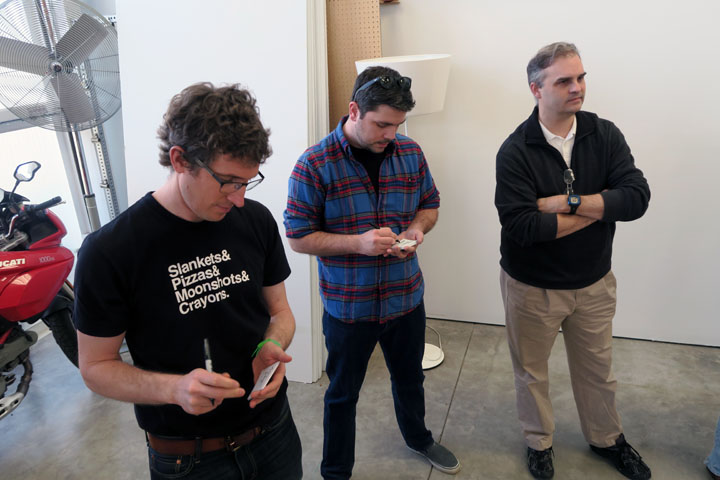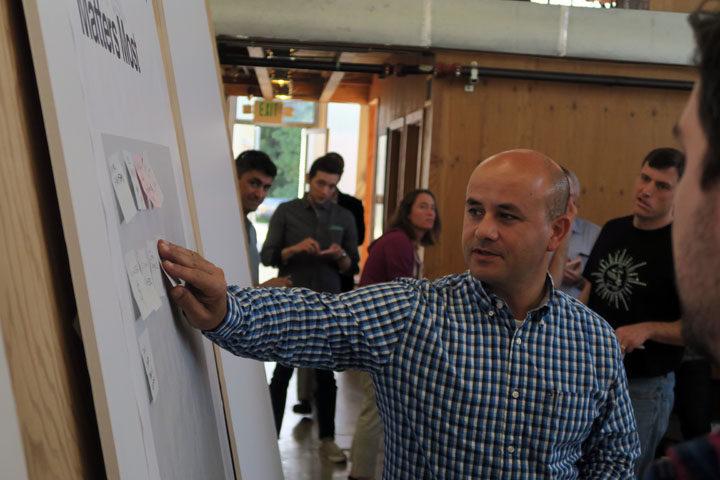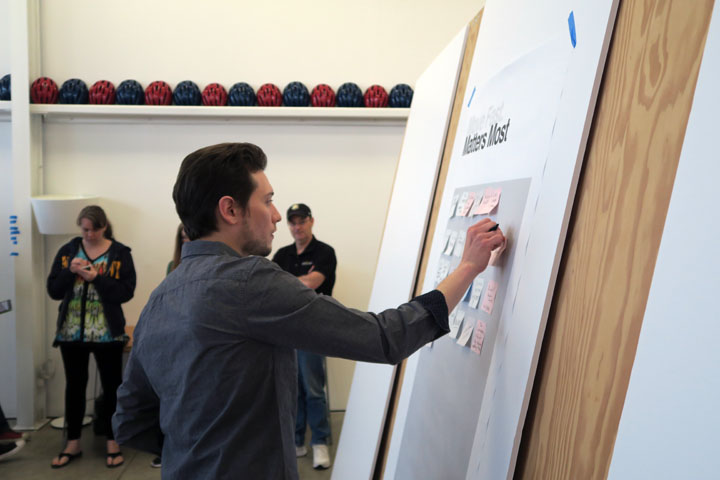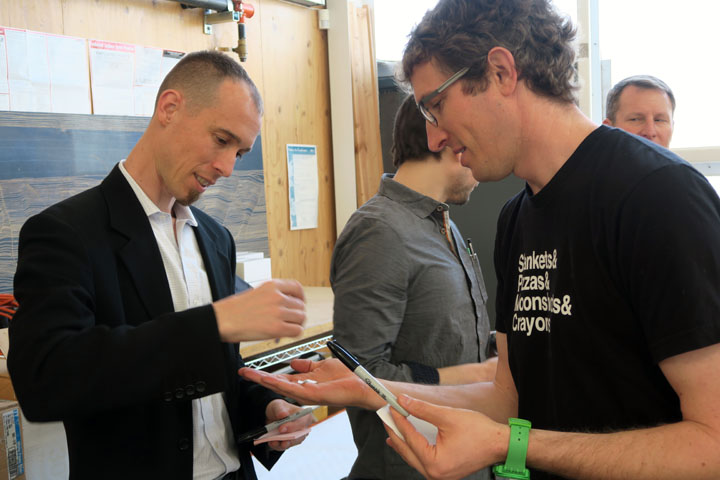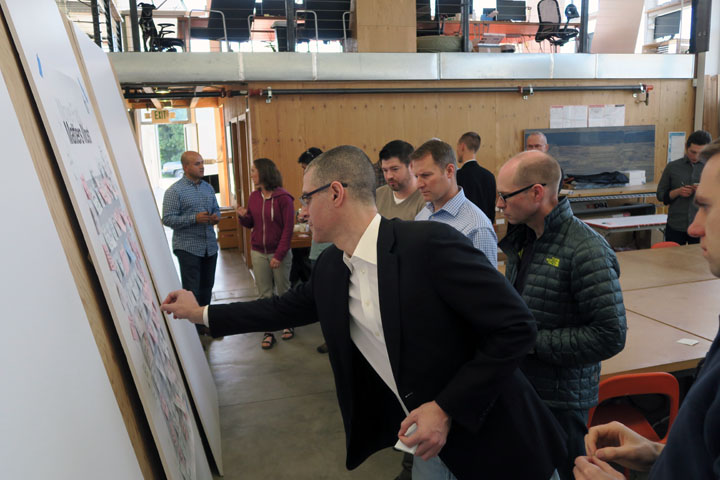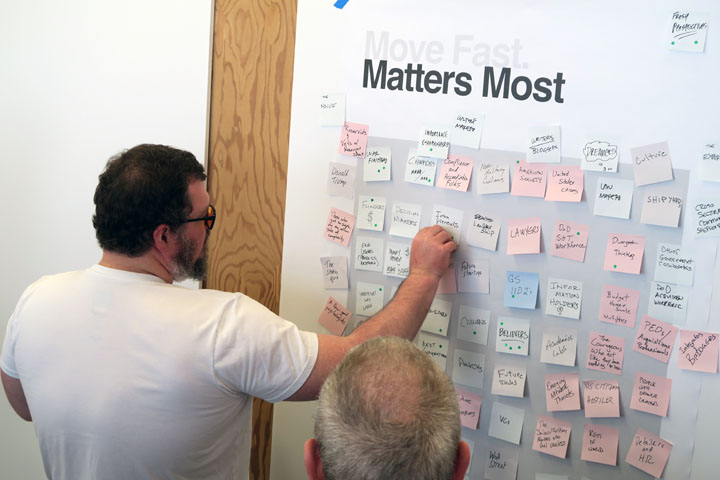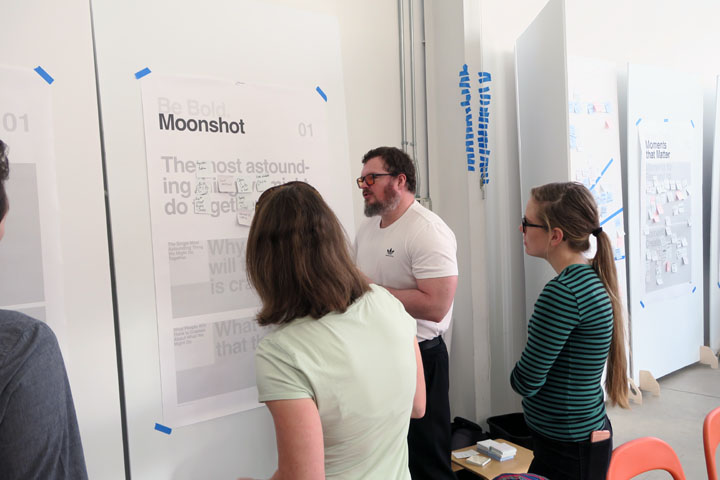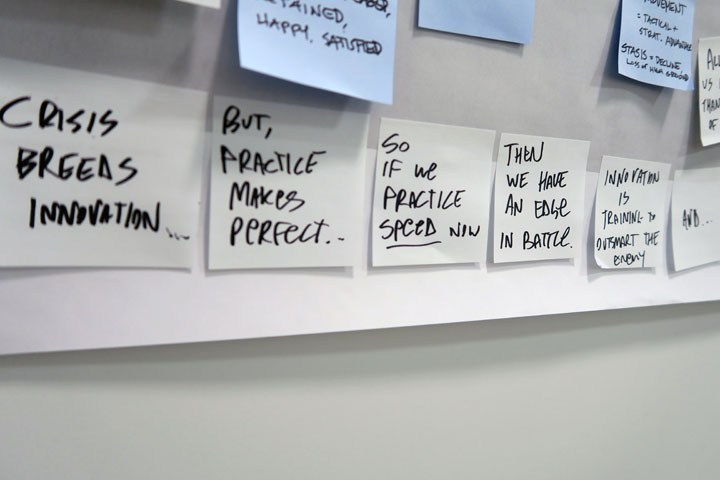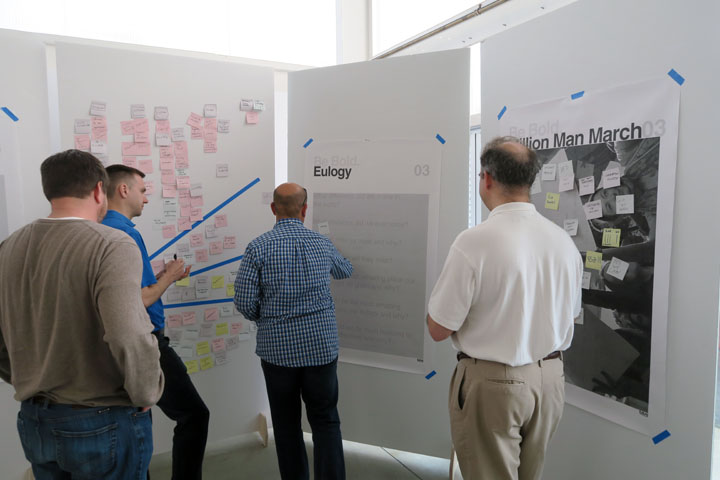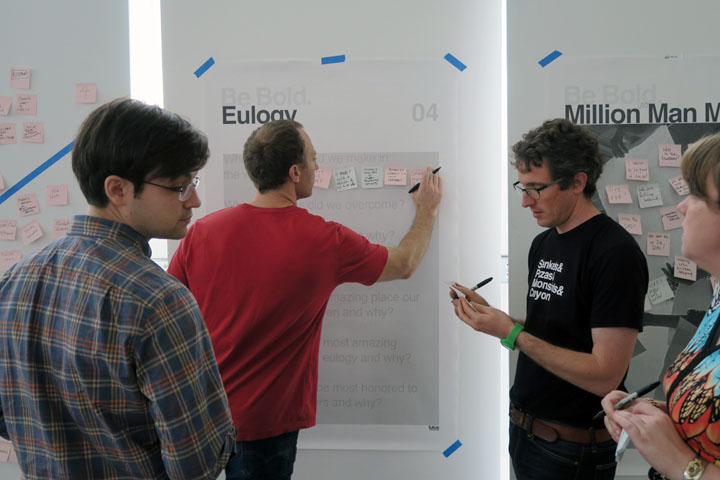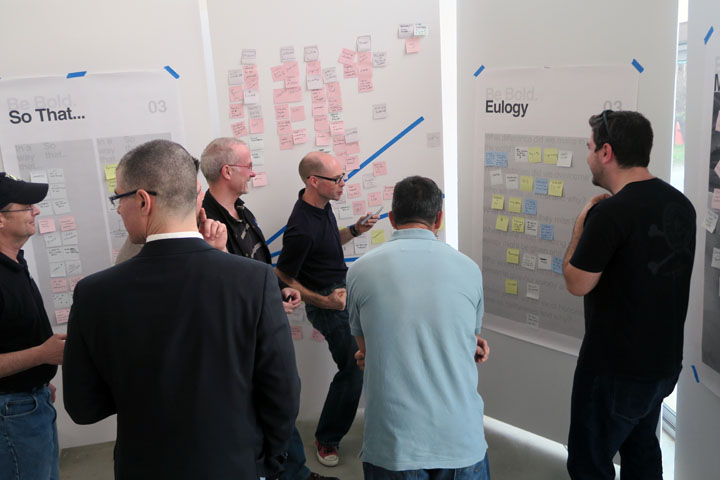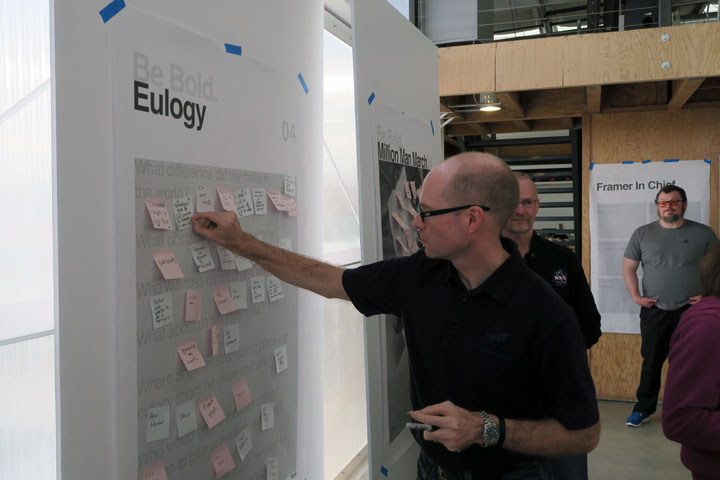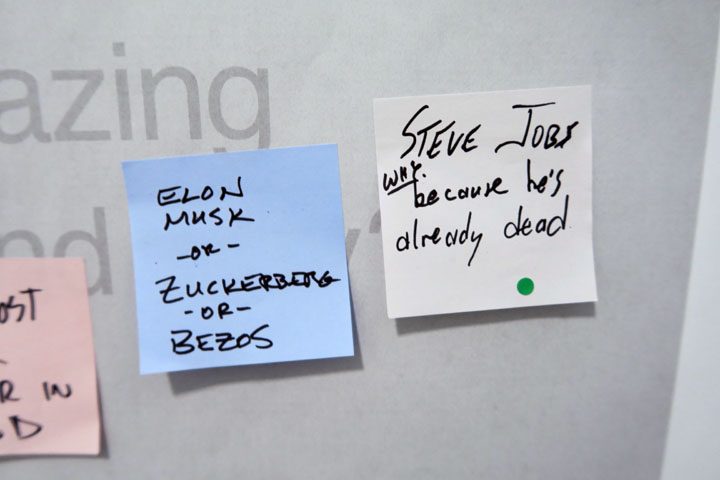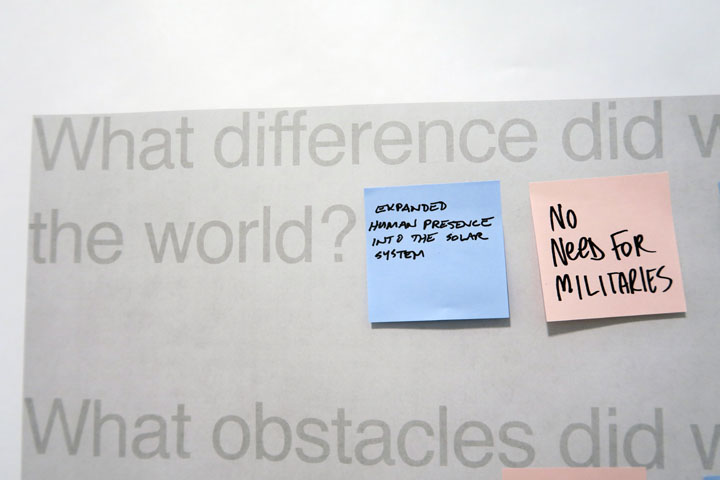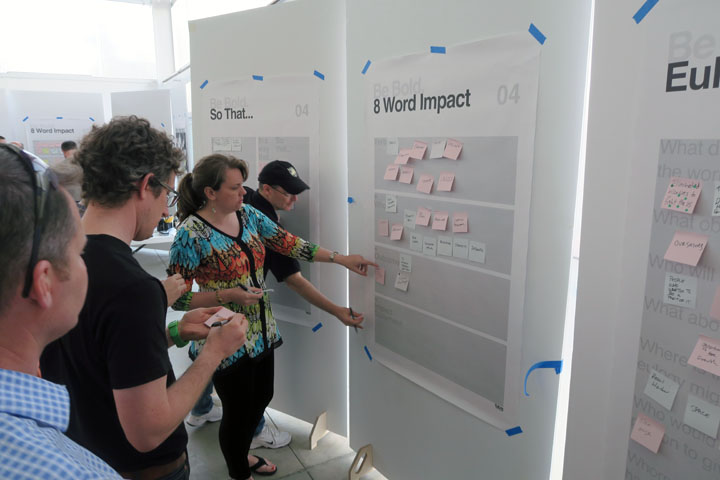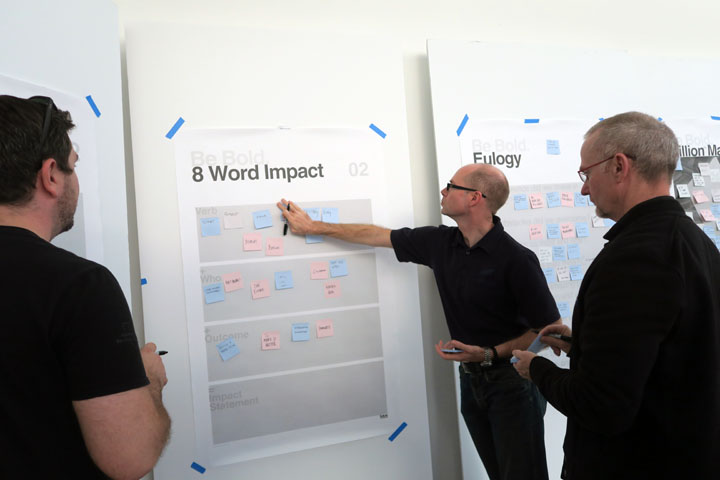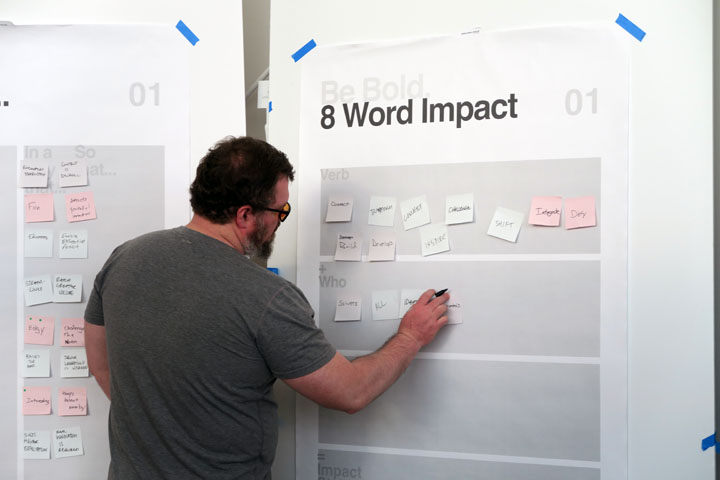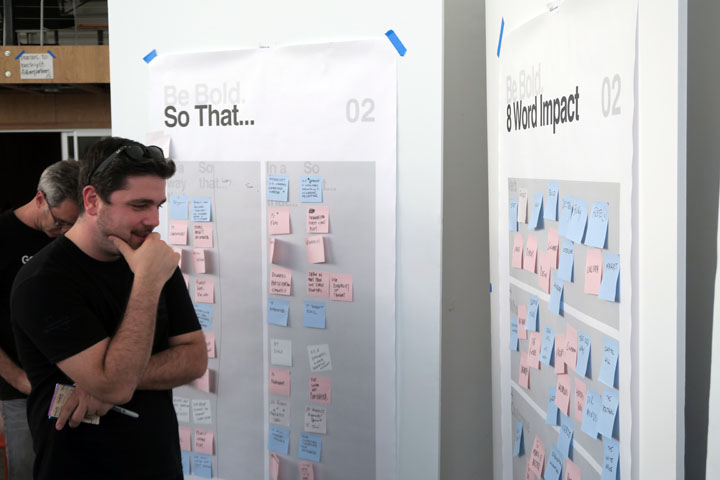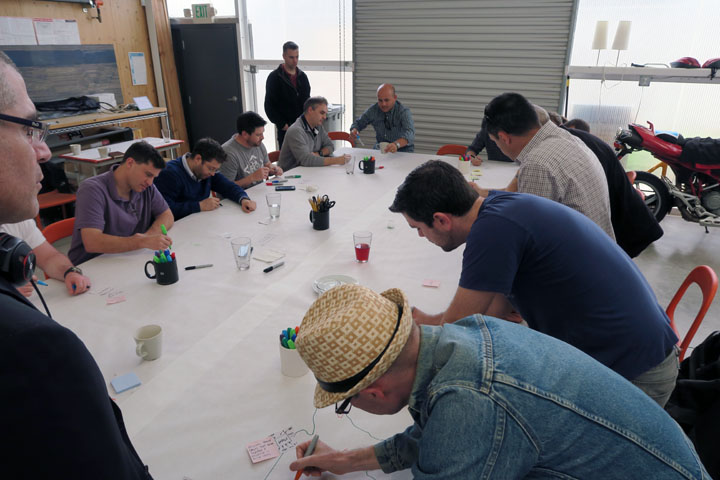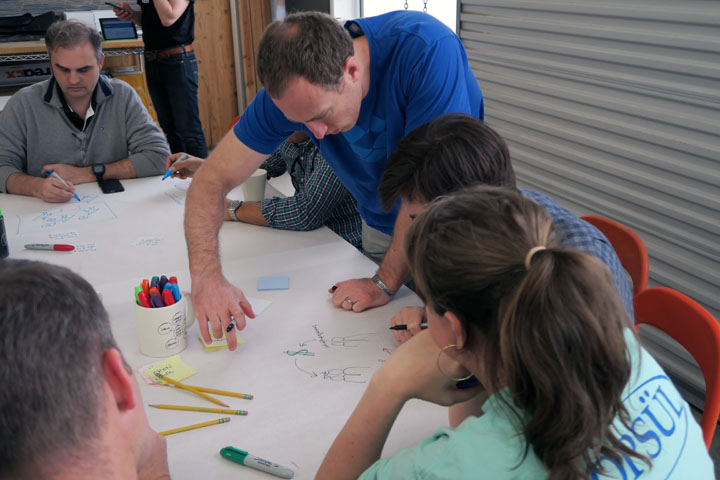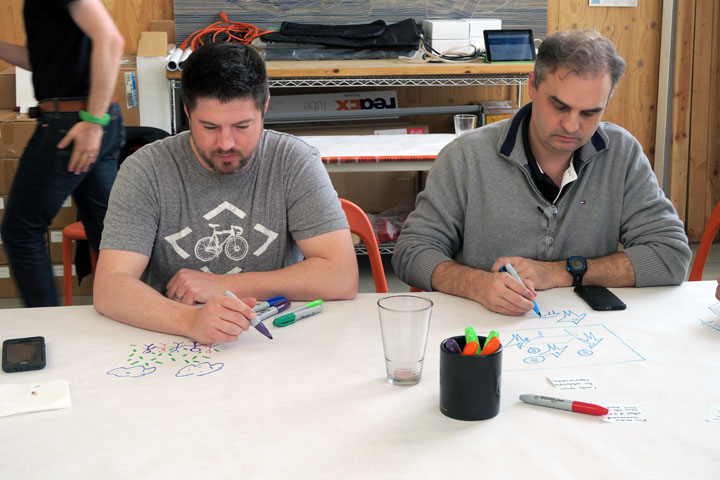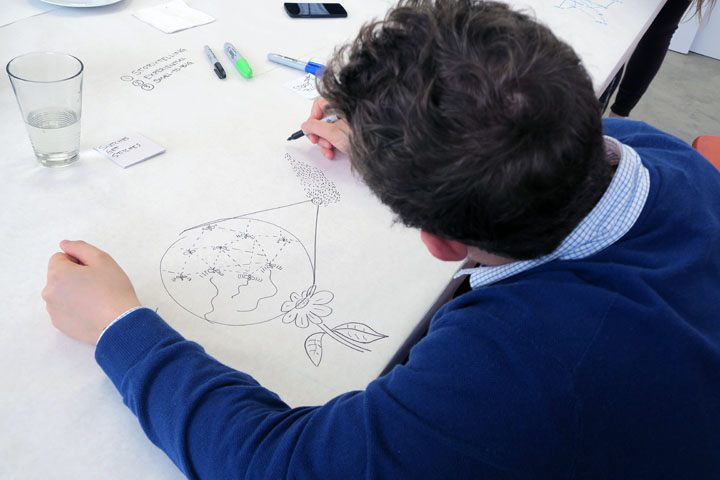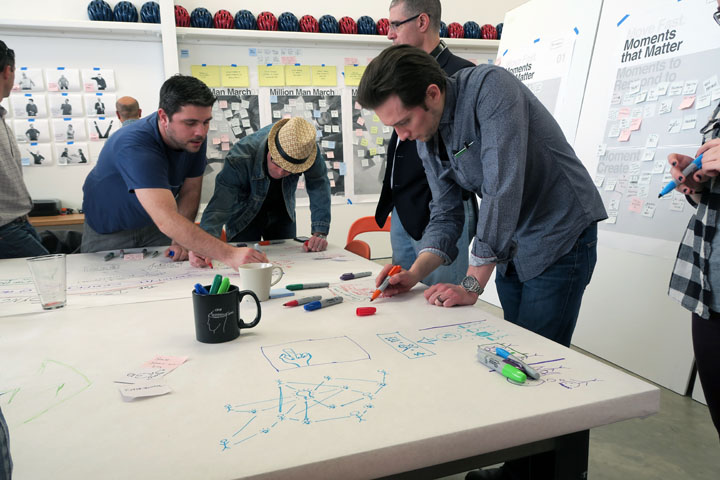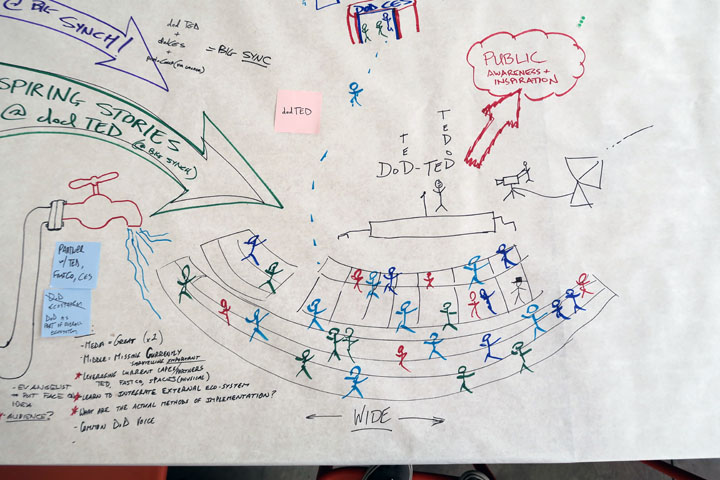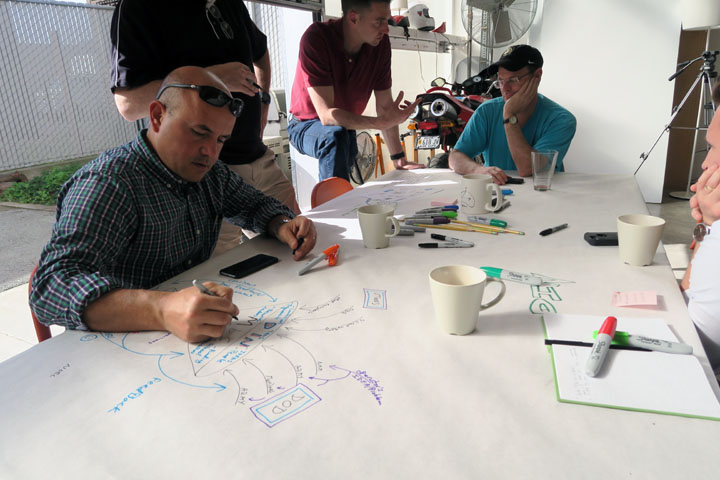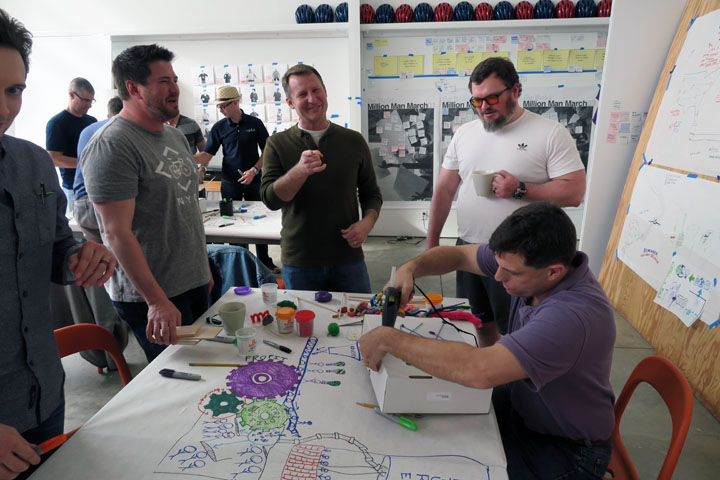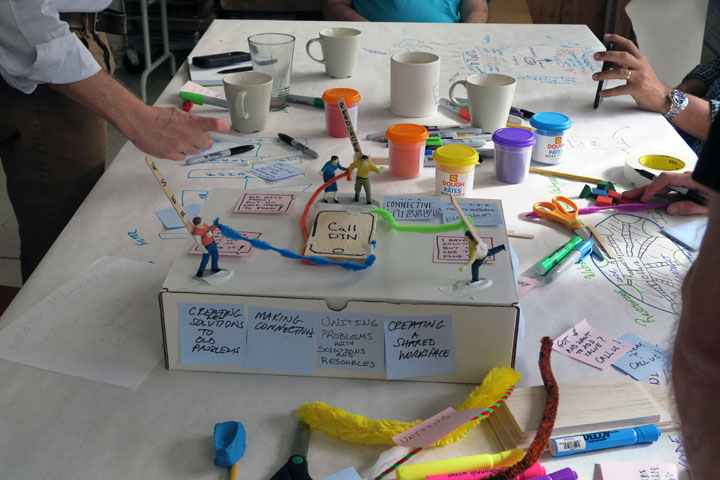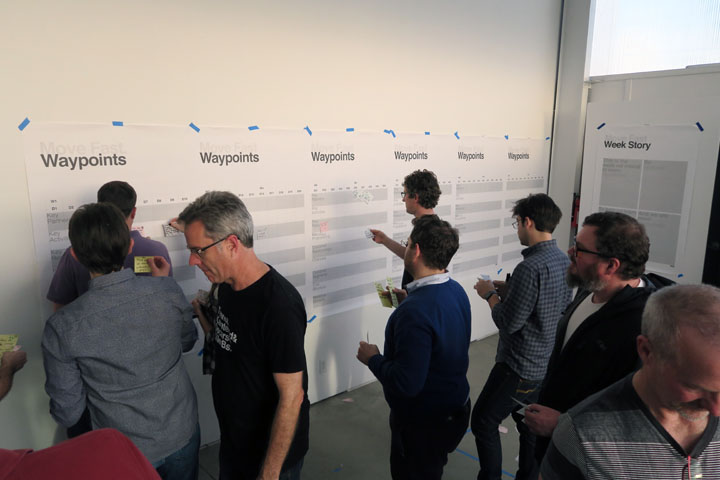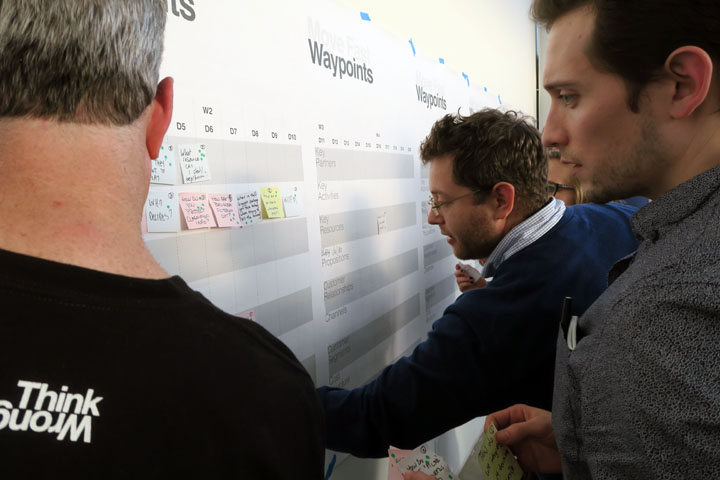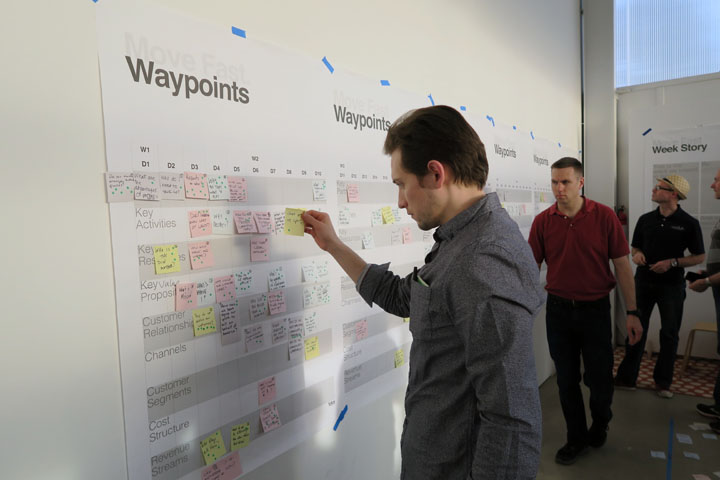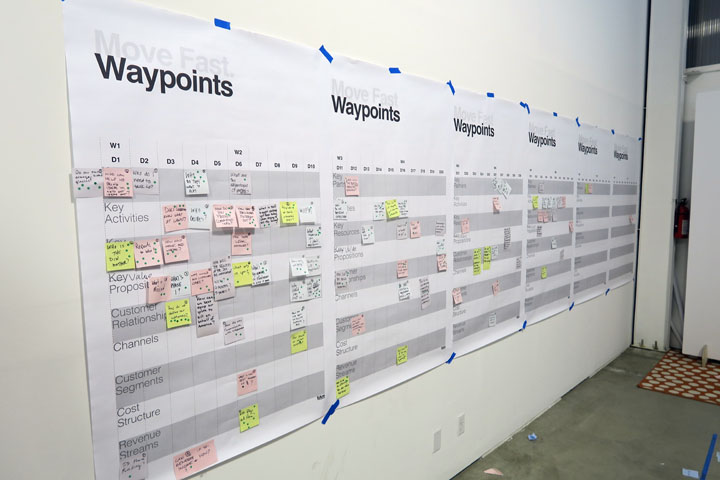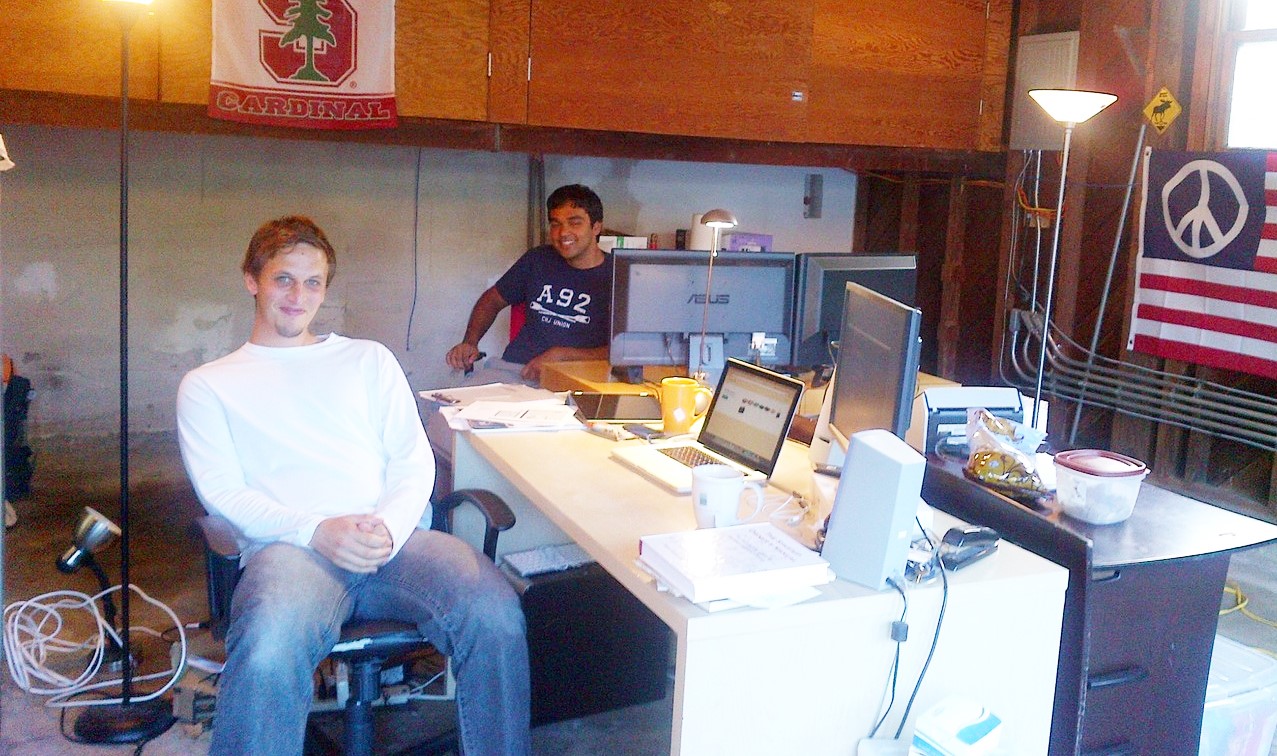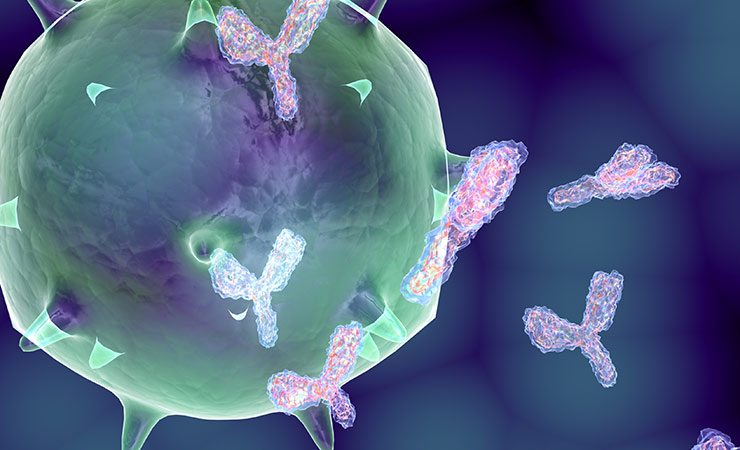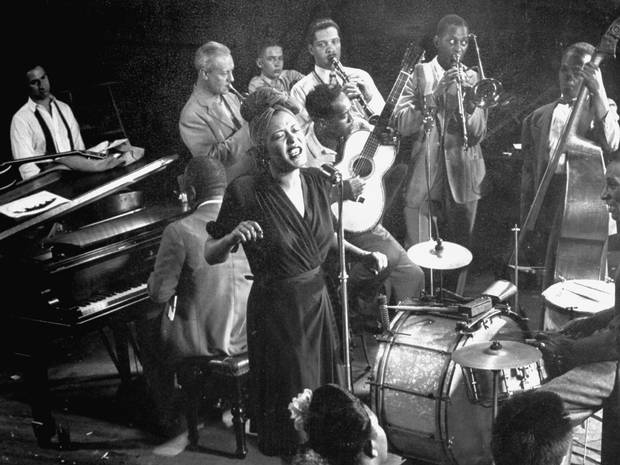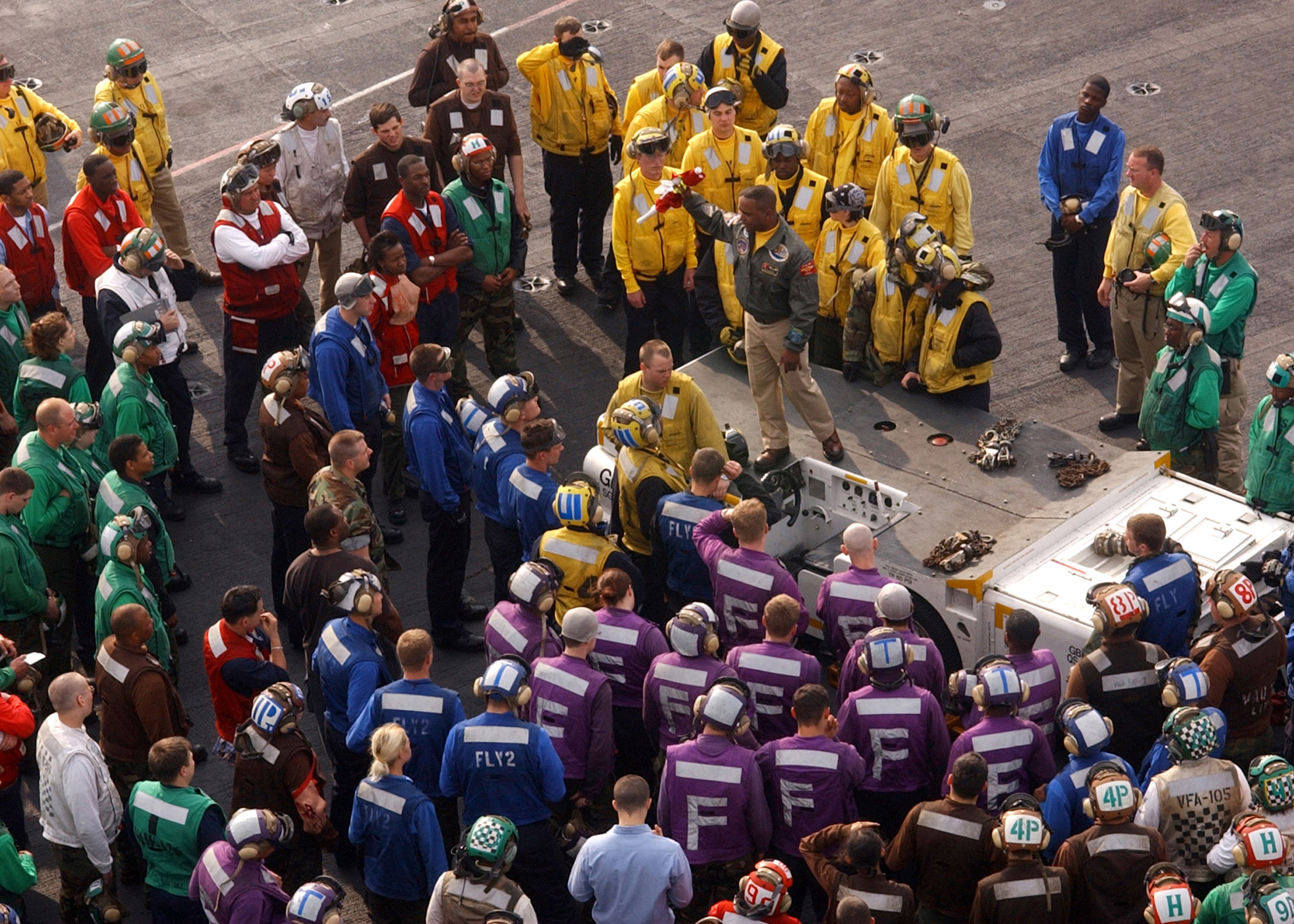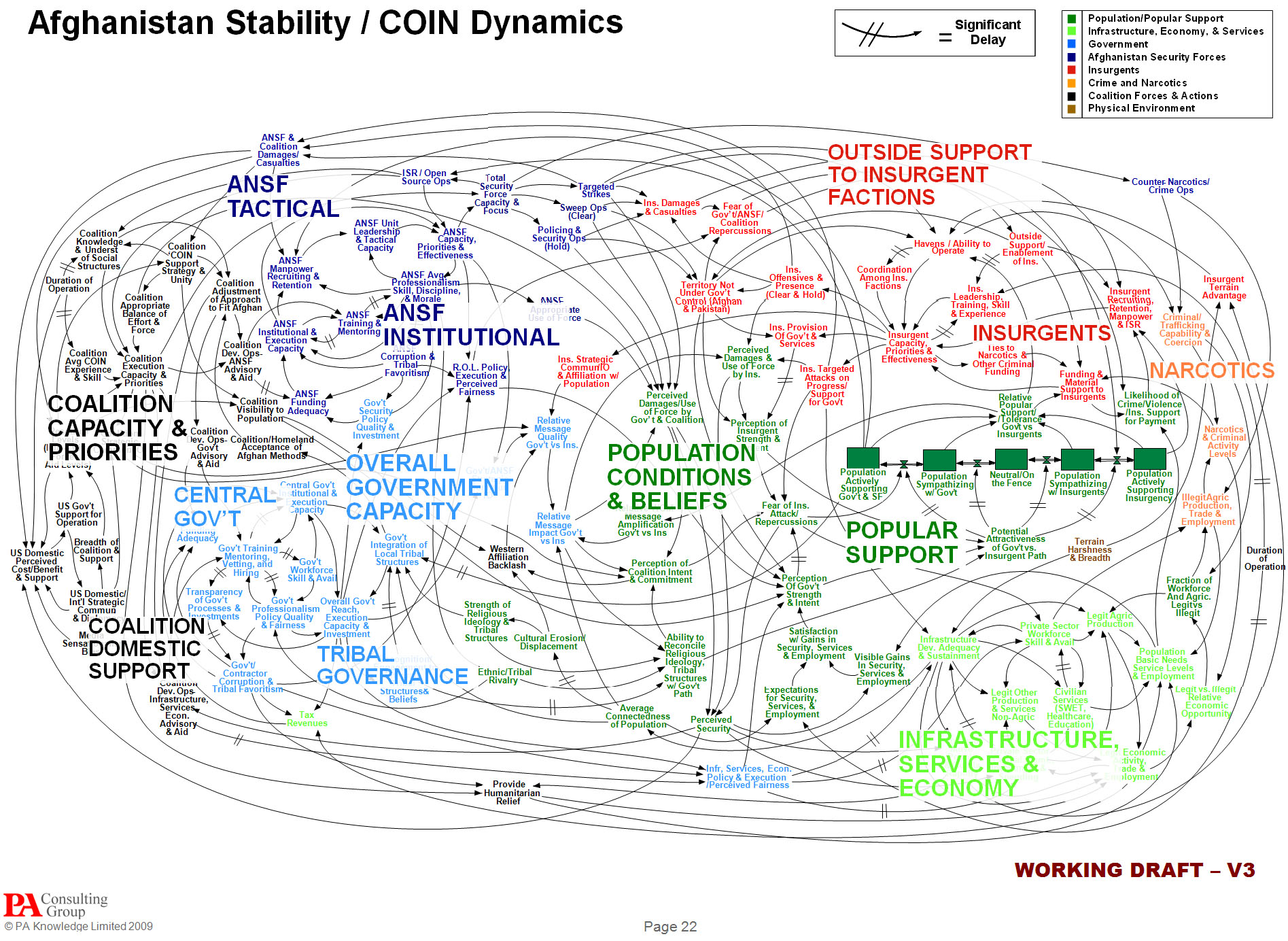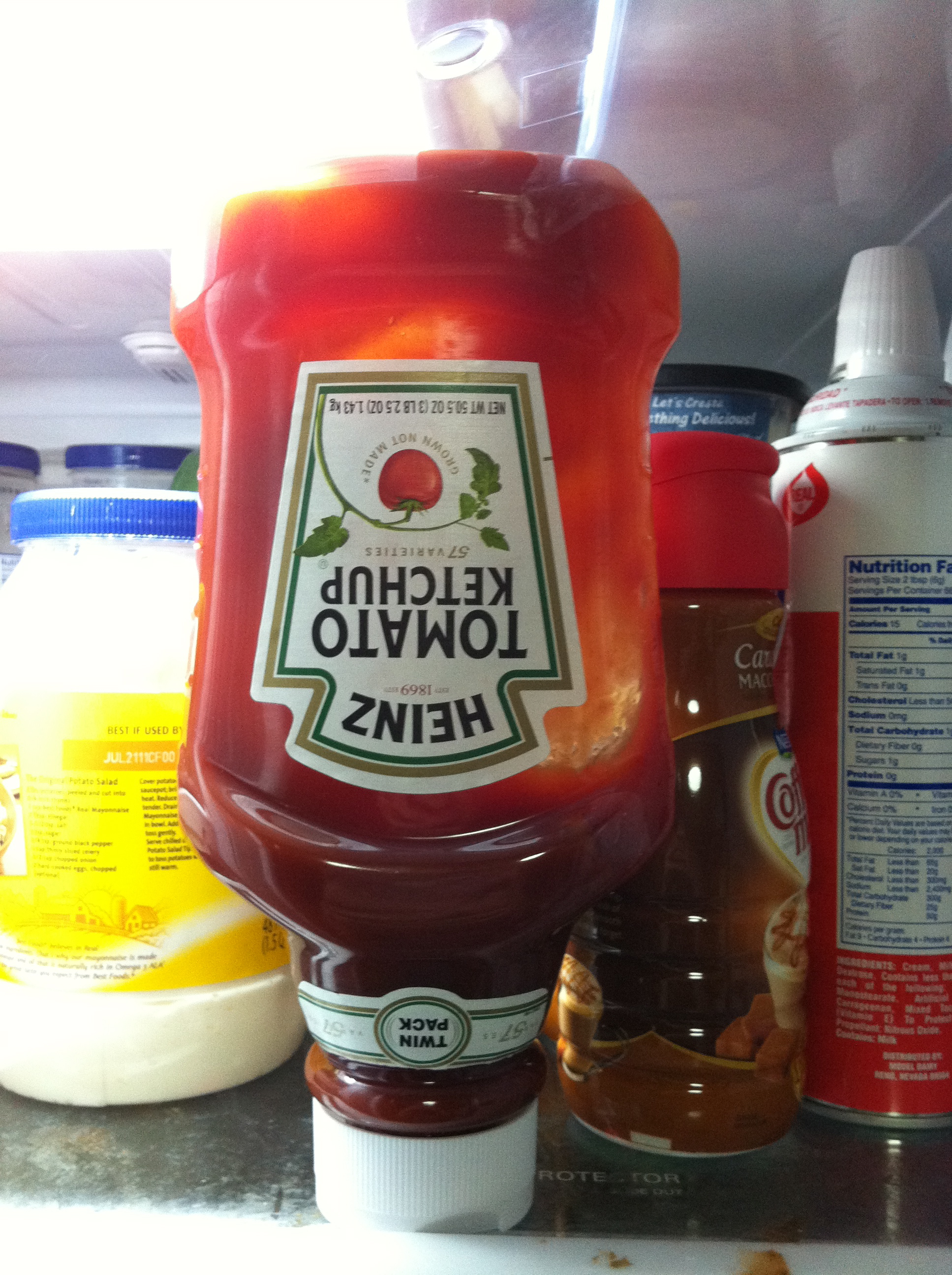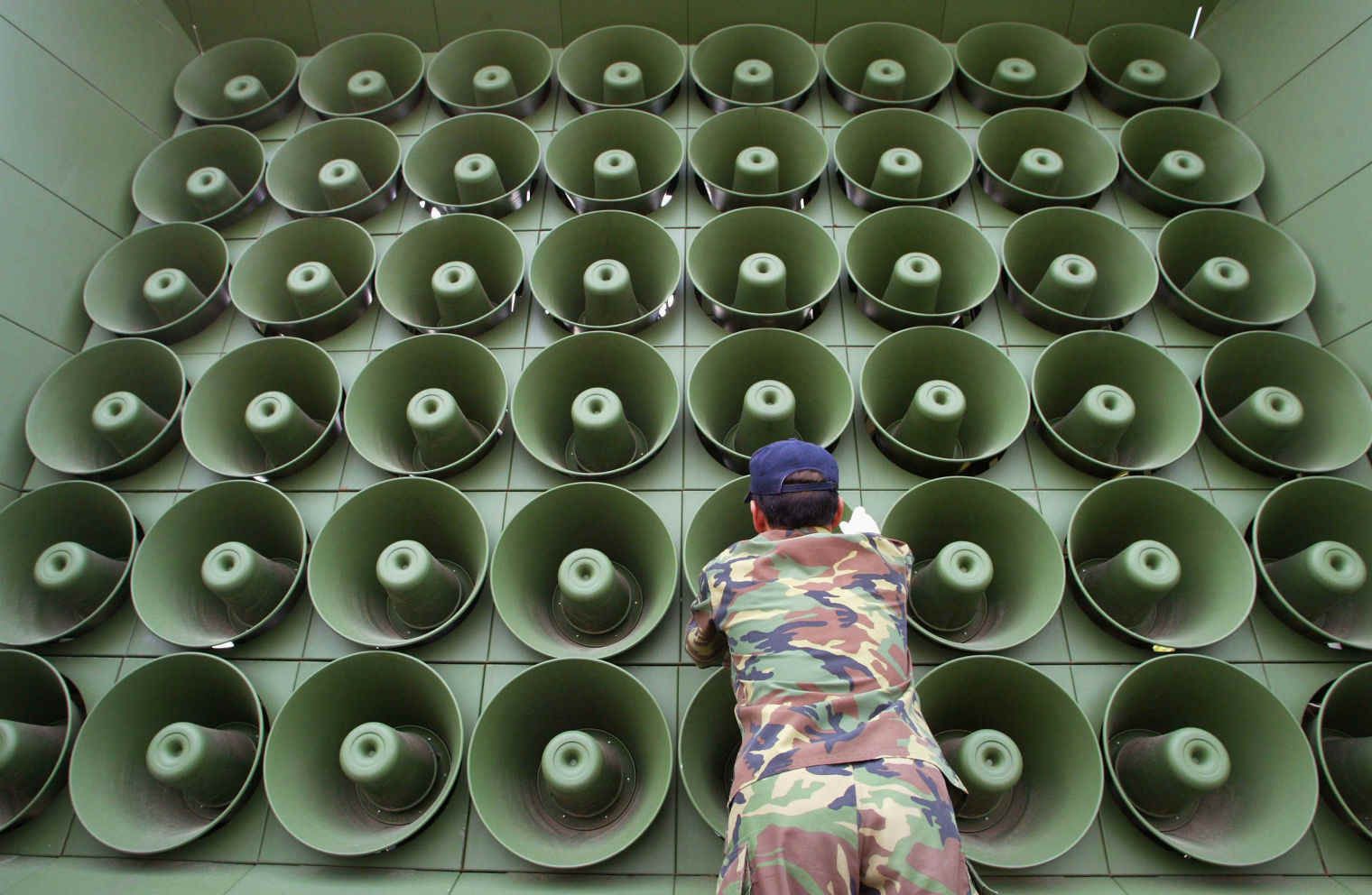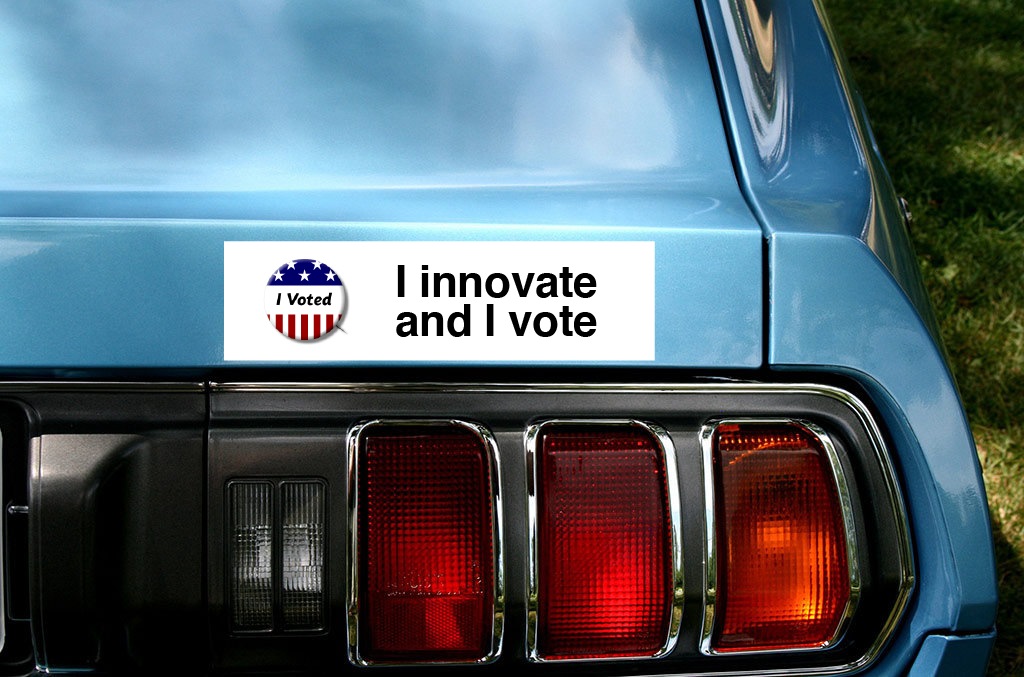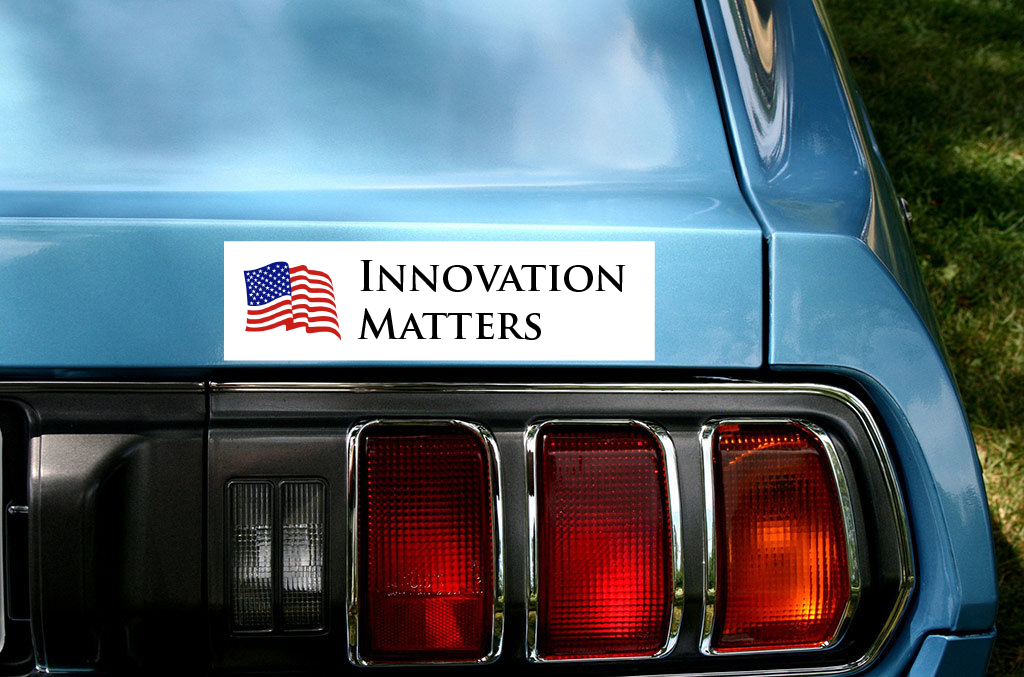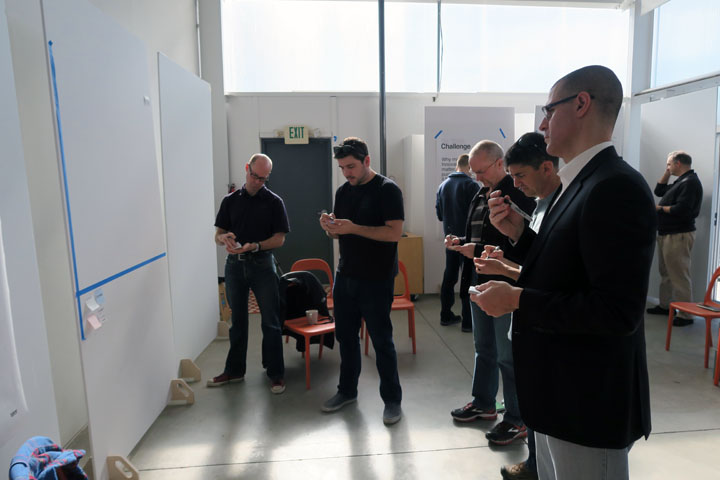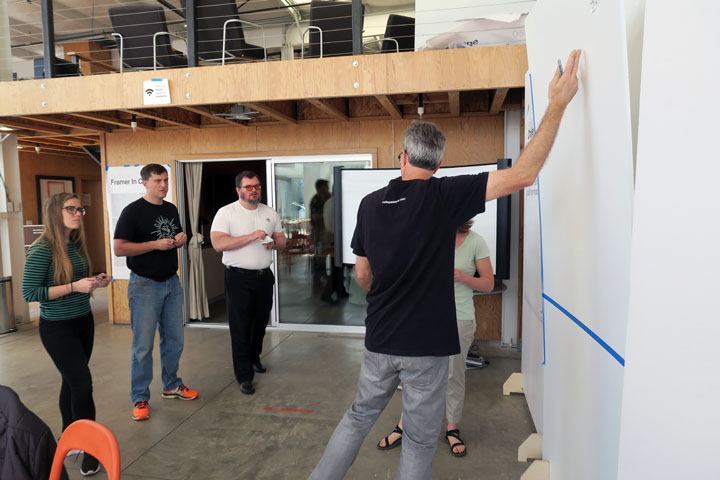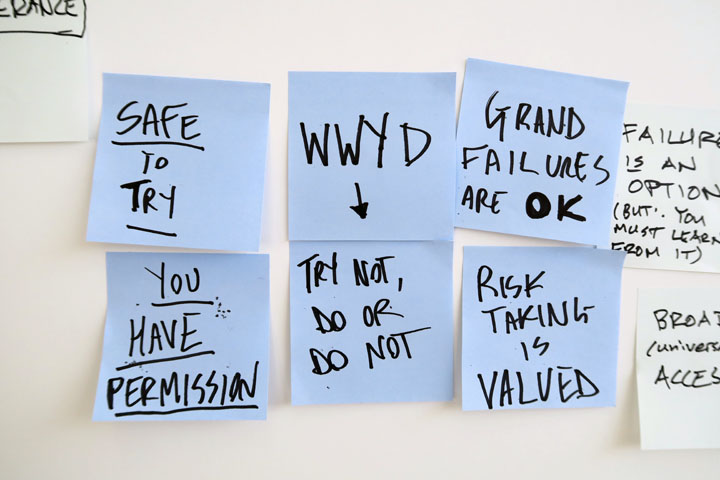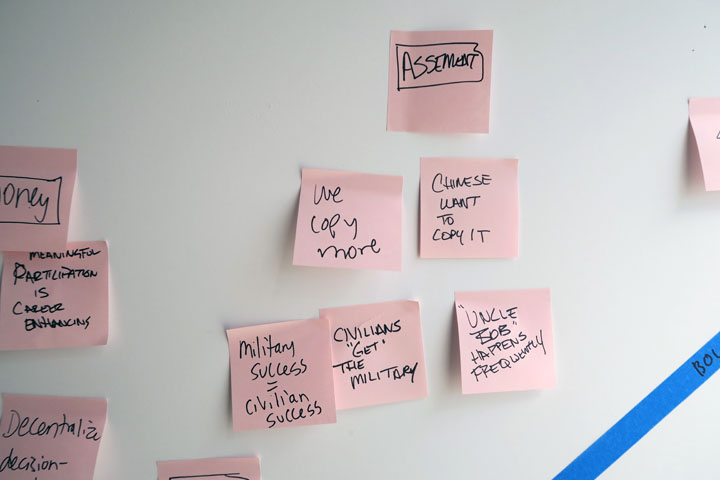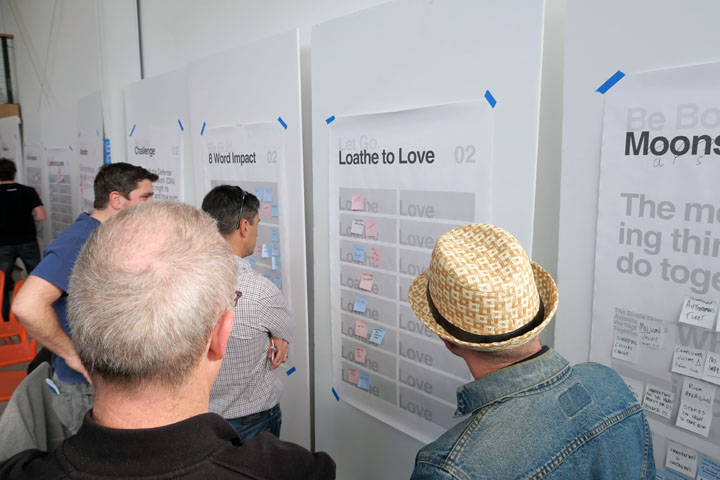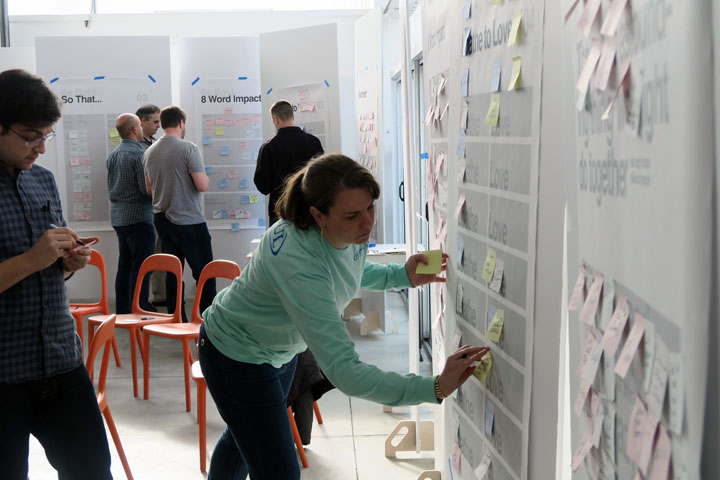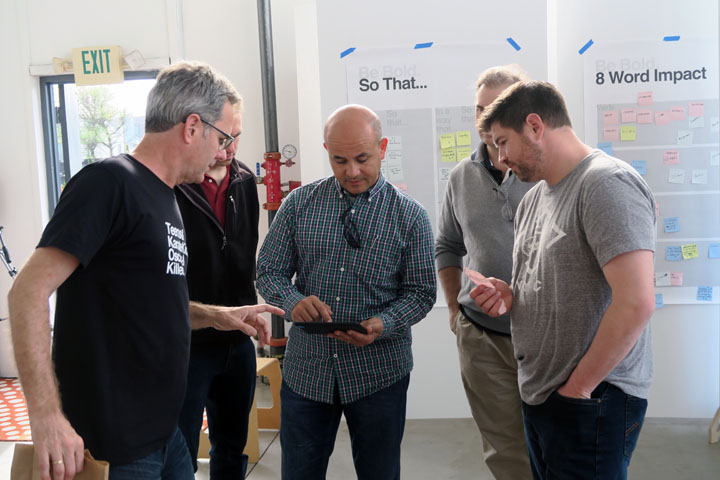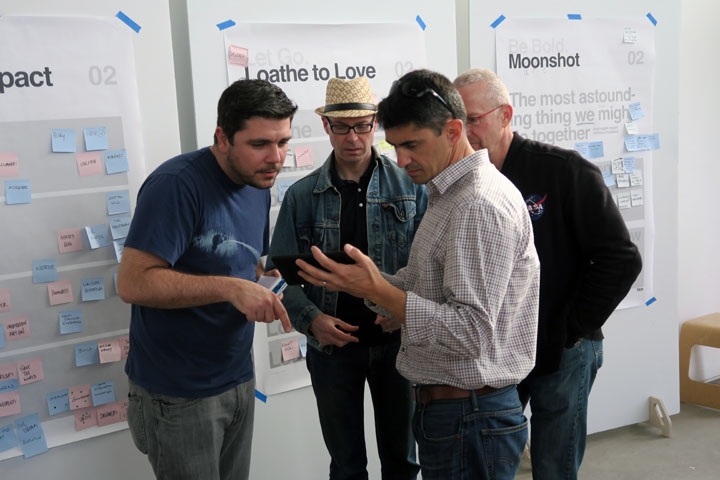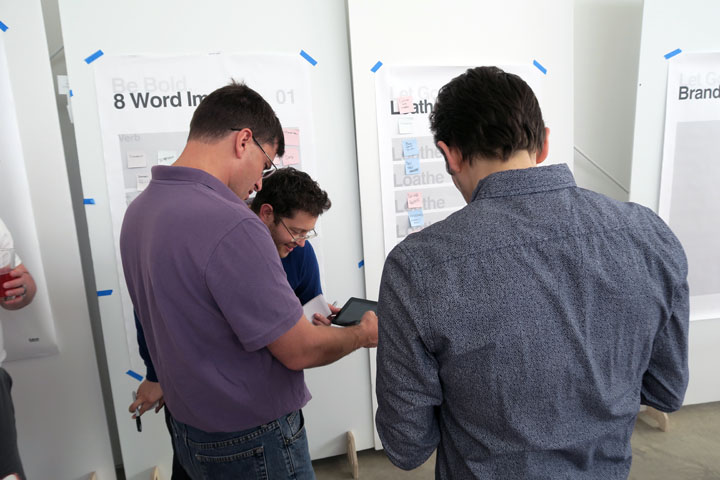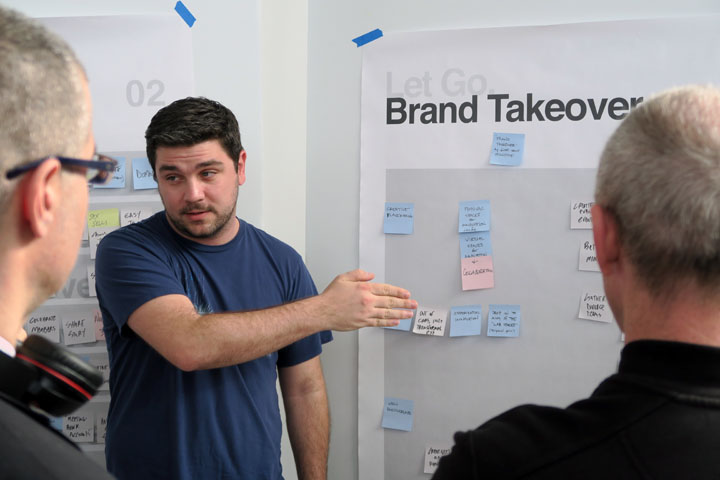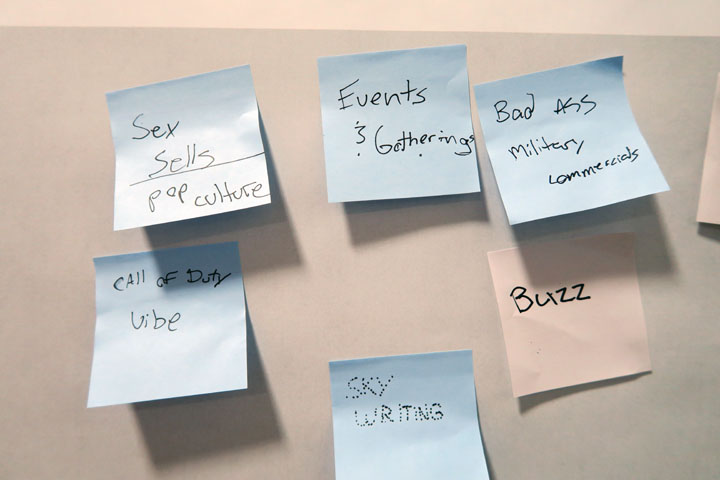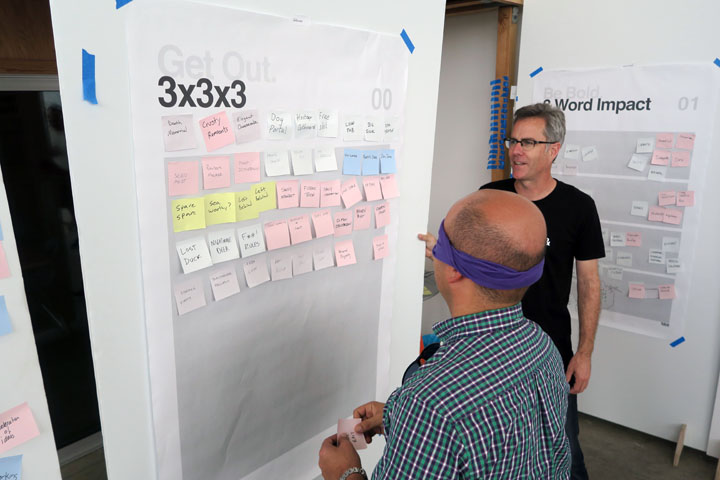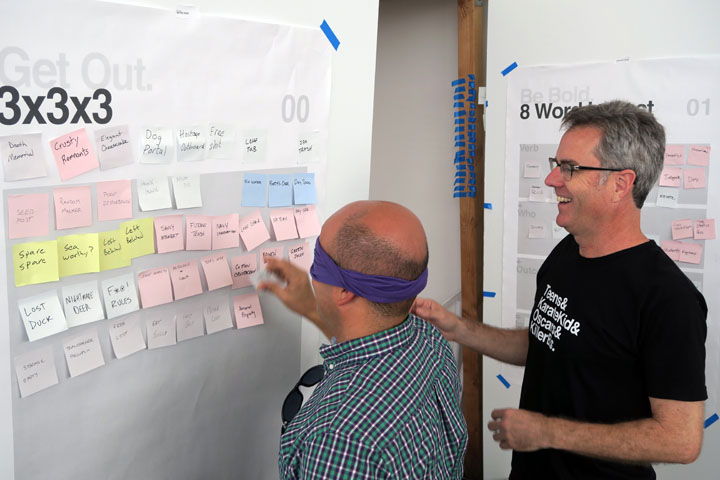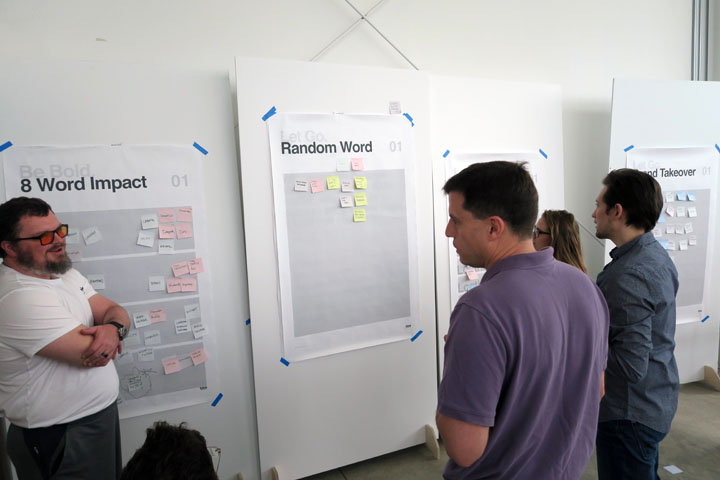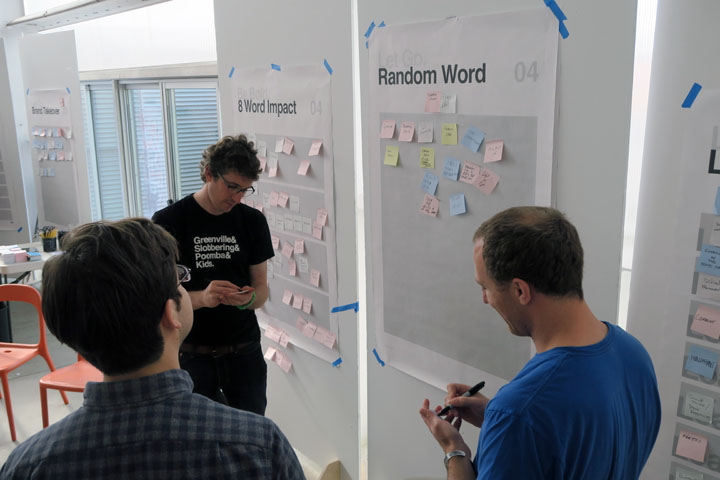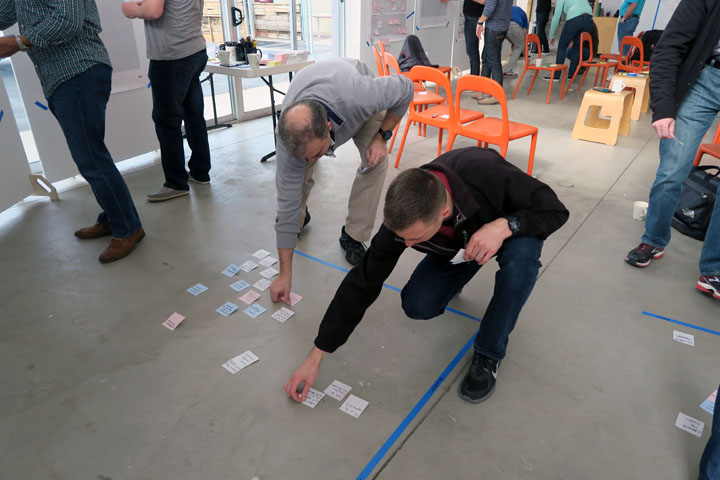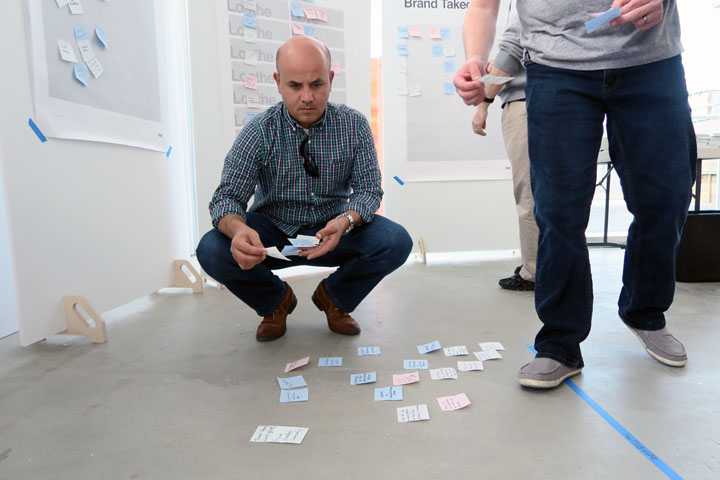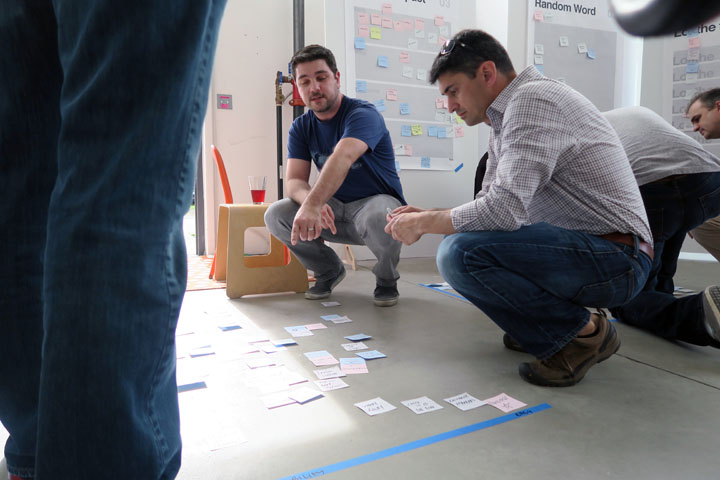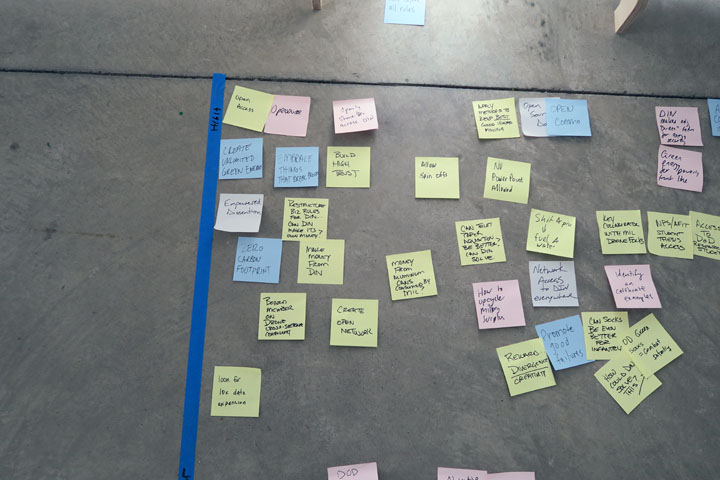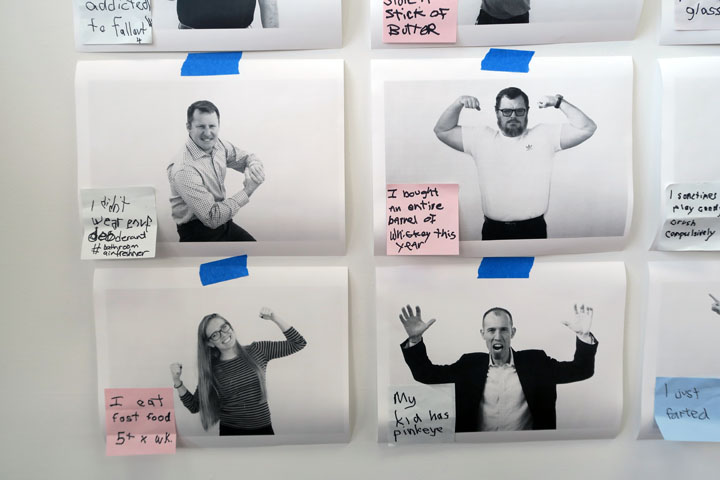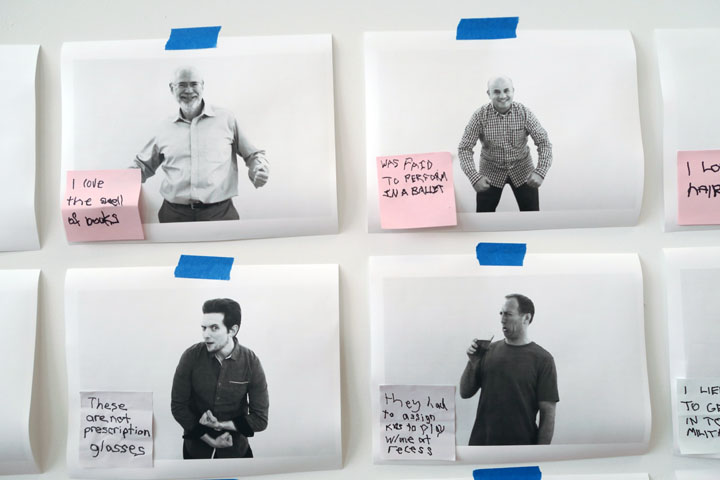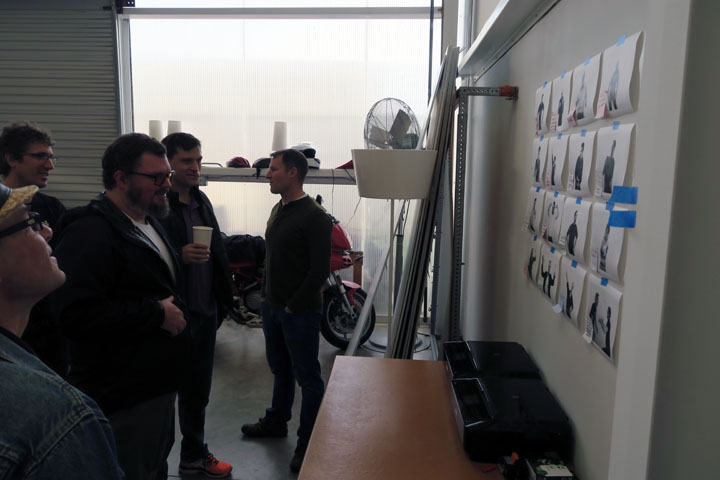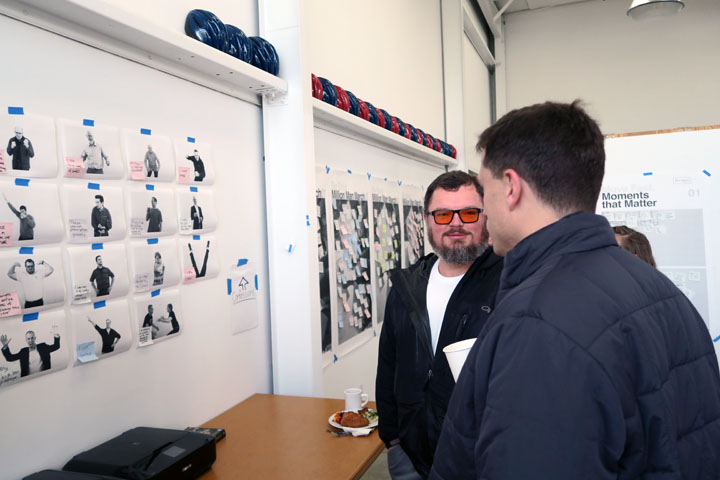DIN Blitz Challenge
DIN Blitz Challenge
Why might the Defense Innovation Network (DIN) matter, what might its purpose be, and how might it fulfill that mission?
On February 10–11, 2016, the National Security Technology Accelerator (NSTA) and a select group of collaborators gathered at The Think Wrong Lab in Half Moon Bay, CA, for the DIN Blitz.
The Blitz was an intense and immersive effort to
explore and articulate the vision, purpose, and target operating model for the Defense Innovation Network.
Our goal
Develop a portfolio of small bets that the NSTA might act on immediately to accelerate the development of a highly effective and productive Defense Innovation Network.
Our objectives
- Align the interests, purpose, and ways of working of the DIN’s key constituents.
- Explore how the Navy’s Athena Project might provide a foundation for a Defense-wide innovation network.
- Generate compelling options for the DIN vision, purpose, and ways of working.
- Generate compelling options describing who the DIN is.
- Generate compelling options for what the DIN produces.
- Generate compelling options for how the DIN might work (a target operating model).
DIN Approach
DIN Approach
Thinking Wrong about the DIN
We used drills from across six Think Wrong Practices to generate a portfolio of small bets that address our challenge and realize our opportunity.
Think Wrong Practices
Dare to make a big difference.
Find fresh inspiration for status quo–busting solutions.
Stretch beyond assumptions, biases, and orthodoxies to expand what’s possible.
Gain insights that can be gotten only through making.
Discover what works without risking it all.
Open up so others can help you improve your solutions and achieve impact sooner.
Think Wrong Drills
Framer-in-Chief
Deflection Point
Moonshot
Million Man March
So That...
Eulogy
8-Word Impact
Challenge Challenge
That’s Odd
3x3x3
Loathe to Love
Brand Takeover
Random Word
Draw It
Biz in a Box
Truth + Truth
I’m a Tool
Matters Most
Moments that Matter
Dog in a Hat
Love & Loathe
When
Waypoints
DIN Vision, Purpose, Model
DIN Vision, Purpose, Model
Exploring the DIN Vision, Purpose, and Model
The Blitz produced compelling options for the impact the DIN might have, why it should exist, how it might work, and why people might join.
First Four Members
We explored who matters most to the DIN’s success.
We selected the four most important archetype DIN members from among dozens of potential members. Each Blitz Team became an advocate for one of the four archetypes so their point of view, needs, and voice might be in the room as we conceived of the DIN.
Team 1:
Funders
Team 2:
Believers
Team 3:
War Fighters
Team 4:
Intrapreneurs
DIN Impact Vision
We developed a portfolio of options for describing the impact the DIN might have.
We used “Moonshot” and “Eulogy”—Be Bold drills—to inspire many different expressions of the impact that the DIN might have. The most compelling options were selected through dot voting.
Team 1
Team 2
Team 3
Team 4
Aim high
(Moonshots)
DIN drives a free-market China.
DIN turns the DoD into a service.
DIN creates a unclass(y) world.
DIN leads the formation of Milicon Valley (Valley 2.0).
DIN inspires sweeping culture change in Defense.
DIN delivers concept to system deployment in two months.
DIN enables flexible deployment; DoD = Deploy on Demand.
DIN cuts military cost in half with twice the capacity in 18 months
Service in the DoD becomes the most desirable job of every Harvard/Stanford/Princeton/MIT graduate.
DoD School of Innovation
Create a legacy
(Eulogies)
We can keep the good guys in charge.
We can save lives.
We can preserve freedom.
We can attract and retain the best.
We can confront the greatest challenges.
The U.S. can lead a model the world wants to follow.
We can lead a Second American Revolution.
We can create a network that will be emulated by governments and companies around the world.
We can offer members a purpose higher than money.
We can create agility for the DoD, DIN members, and warfighters everywhere.
We can create relationships that transcend the DIN.
We can transform the relationship between the DoD and Congress.
We can eliminate incentives to fight the U.S.
We can help the DoD deliver technologies that drive the economy for years.
We can keep the U.S. safe.
We can make it futile to threaten the U.S. and her allies.
We can advance the U.S. technology dominance.
We can raise the intellectual bar for America.
DIN Purpose
We created a wide range of options for how we might communicate the DIN’s reason for existing.
We used “8-Word Impact”—a Be Bold drill—to generate purpose statements for the DIN. The most compelling options were selected through dot voting.
Team 1
Team 2
Team 3
Team 4
To lubricate the defense community.
To respond to an uncertain future.
To foment freaks, geeks, and weirdos to save the world.
To overcome convention to create exponential innovation.
To unite dreamers and create the future.
To defend the U.S. by disrupting threats to global prosperity.
To open the DoD innovation doors to all companies and military members.
To transform military research and development to change the world.
To leverage the global tech base to eliminate armed conflict.
To catalyze innovative talent networks to solve U.S. challenges.
To catalyze talent networks to spark high-impact solutions.
To excite talented citizens to disrupt ourselves first.
To unlock hidden genius to effect change.
Make It Real
We explored operating models and why people might join the DIN.
We used “Draw It” and “In a Box”—Make Stuff drills—to explore how the DIN might engage members and operate.
DIN in a Box
Respond to an uncertain future.
Save Me
Preserving precious resources.
Call DIN
Uniting problems with solutions and resources.
I’m with the Band
Get in sync, stay in sync.
Waypoint Planning
We identified and prioritized big questions that might drive the development of the DIN.
The DIN is charting new territory—attempting to build an innovation network that spans all branches of the military—on the foundation of past successes within individual branches.
We used “Waypoints”—a Move Fast drill—to surface the most important questions that we should be considering to discover what it will take to stand up and operate a successful Defense Innovation Network.
Key Partners
Member Desirability
Why might key partners want to participate?
Who might key partners need and want to talk to?
What are the biggest challenges key partners face today?
Execution Feasibility
Who might help the DIN bring ideas in and get ideas out?
Key Activities
Execution Feasibility
What might leadership need?
How might we protect classified information?
Key Resources
Execution Feasibility
Who might be responsible for the DIN?
How much space might be needed and where might the DIN be located?
Who might report to whom?
Value Proposition
Member Desirability
Why might members care?
Execution Feasibility
What might the DIN mission be?
How might the success of the DIN be measured? Now? In 6 months? In 5 years?
Economic Viability
What might Phase One of the DIN be and require?
Member Relationships
Member Desirability
How might we define our members?
What are the biggest challenges members face today?
Execution Feasibility
How might we define our members?
How might we best equip our military forces to defend America?
Channels
Member Desirability
How might members communicate with collaborators?
Revenue Streams
Execution Feasibility
How might the DIN generate income?
Economic Viability
Where might funding for the DIN come from?
Week 1
Week 2
Key Partners
Execution Feasibility
What might be the advantages of partnerships?
Key Activities
Execution Feasibility
How might the DIN filter bad actors out?
How might the DIN reach interested people?
Economic Viability
What might be in it for members?
Key Resources
Execution Feasibility
What might be the legal obstacles?
Economic Viability
What resources might we steal/beg/borrow?
Value Proposition
Execution Feasibility
What might set us apart?
What measures of effectiveness might help keep the DIN going?
Economic Viability
How might a bottom-up approach affect funding?
Member Relationships
Economic Viability
Why might members trust us?
Why might members invest time with us?
Channels
Economic Viability
How might we get visibility outside of the DoD?
Member Segments
Execution Feasibility
How might we market the DIN?
Cost Structure
Execution Feasibility
What might be the best allocation of money?
Revenue Streams
Economic Viability
Who might pay and how?
Week 3
Key Partners
Execution Feasibility
When might the right people be available?
Key Activities
Execution Feasibility
How might we “filter” needs?
How might we integrate government decision makers?
Key Resources
Execution Feasibility
How might we link or own?
Member Relationships
Member Desirability
How did you build your network(s)?
Member Segments
Execution Feasibility
How might we best support our different members?
Revenue Streams
Execution Feasibility
What might we do differently than other efforts that have failed?
Week 4
Key Activities
Execution Feasibility
How might we prioritize needs across member segments?
Economic Viability
How might we define baseline expectations?
Key Resources
Execution Feasibility
How might we become/stay familiar with current technologic memes?
Economic Viability
Should the DIN be funded at all?
How might the DIN be staffed? Any 1102s?
Value Proposition
Economic Viability
Who might curate?
Member Relationships
Member Desirability
From where might you source a problem?
Military DoD labs? Private companies? Startups?
Channels
Member Desirability
How might we most effectively communicate internally?
How might we most effectively communicate externally?
Economic Viability
What existing mechanisms in the DoD might we leverage? SBIR?
Revenue Streams
Execution Feasibility
How much money might we need to operate?
Week 5
Key Resources
Member Desirability
How might I use your lab?
Member Relationships
Member Desirability
How might we make it more expensive for the enemy to attack us?
How might we make it less expensive to defend ourselves against the enemy?
Member Segments
Member Desirability
Who might members need to talk to?
Week 6
Key Partners
Execution Feasibility
Who might be the shepherds for the outlaws?
Who might be Yoda?
Who might be the Jedi?
Key Activities
Economic Viability
How might we ensure that there is enough content to make it worthwhile for members to keep participating in the DIN?
Value Proposition
Execution Feasibility
How might we ensure that every day we increase the likelihood that young kids will survive the next war?
Member Relationships
Economic Viability
How might we deliver value—fast?
Channels
Member Desirability
What channels might be most effective?
Member Segments
Execution Feasibility
How might a small company play?
Revenue Streams
Execution Feasibility
What measures of success, beyond revenue, might matter most?
Week 7
Key Partners
Member Desirability
How might I be able to work with my competitors?
Key Activities
Execution Feasibility
How might we manage ROI?
Economic Viability
How might we acquire members?
Who might do member acquisition?
Key Resources
Member Desirability
How might I decide what people are the right fit?
When might I get paid?
What might be in your lab that I could use?
Member Segments
Economic Viability
What if we dumped 50% of SBIRs into the DIN?
Week 8
Key Activities
Member Desirability
How might I play?
What might be the DIN’s nail (the big point we need to communicate)?
Execution Feasibility
How might I market inside government/outside government?
Key Resources
Member Desirability
What key resources might be required from members?
What key resources might be available to members?
Value Proposition
Economic Viability
What might members and partners be willing to pay for and how much might they be willing to pay for it?
Member Relationships
Economic Viability
Who might be listening to the DIN?
Channels
Member Desirability
How might the DIN protect my IP?
Week 9
Key Partners
Execution Feasibility
What might be the DIN’s strategy to stop those who stand in the way?
Week 12
Value Propositions
Economic Viability
How might the DIN outlast the “Innovation” craze?
DIN Operating Model
DIN Operating Model
Imagining the DIN Operating Model
The Blitz produced valuable insight into essential qualities of the the DIN Operating Model
DIN = Startup
The Blitz revealed that the DIN will encounter many of the same challenges as traditional startups.
The startup world uses many military metaphors. The skills and concepts the military excels at and teaches its people are the same that are required to make a successful startup:
Competition
Leadership
Strategy & Tactics
Operations
Logistics
The DIN must also possess the same strengths as startups—identifying market fit, acquiring customers, discovering business models, and being ready and able to pivot.
Competition
Scale and growth
Leadership
Speed & Agility
There are many existing programs across the DoD promoting innovation. The DIN needs to identify why it’s better suited to succeed where other efforts have not. While competition within the DoD is not the same as in the open market, the DoD still needs to compete for mindshare, funding, and support.
Many startups stumble as they grow. It makes sense for the DIN to start small and learn what’s needed to execute a portfolio of small bets. But the DIN needs to have a strategy in place to quickly scale operations and logistics. As Benjamin Franklin said, “If you fail to plan, plan to fail.”
A key asset for any early-stage startup is talent—creative, dedicated, and smart leaders can make the DIN successful. A lack of them will ensure failure. Innovative and intrapreneurial talent exists within the DoD. The DIN will need to be able to call upon this talent to succeed.
The DIN will need to be a fleet-footed, agile group within a large bureaucratic organization to avoid being assimilated. To build a DIN that can deliver sustainable value, it should go through an intense, quick incubation to assess desirability, feasibility, and viability. That way, it can gain a clear understanding of the most compelling needs the DIN addresses, who its beachhead members might be, what it will offer, and how it will operate.
Manage Mother
How does the interloper survive and resist the antibodies to change?
As a startup, the DIN will face a multifronted battle—trying to produce innovation inside the massive DoD while fighting off the antibodies that the host organization will send out to minimize risk and disruption.
The DIN must have a strategy for managing the DoD mothership, so it can gain enough freedom to grow while maintaining the support required to sustain itself.
Outlaws
Shepherds & Sheriffs
Sherpas
Provide a den for the Outlaw gang—a safe space in which to innovate.
Enlist Shepherds to protect the Outlaws from the Sheriffs (whose job is to uphold rules and the law) while championing innovation at the top levels of the DoD.
Deploy Sherpas to help the Outlaws navigate and explore new innovation territories.
On-Ramp/Off-Ramp
The DIN can effectively capture the passion, innovation, experience, and skills of some of the best leaders in the world—even those who left the military.
A frothy brew of mediocrity results from a culture that encourages zero defects over risk taking, promotes people regardless of merit, and compels its young, talented people to leave before they can ascend the ranks and influence critical change. Too often the mediocre stay, remain reluctant, and are rewarded for resisting change and shunning risk.
This situation is no different than in many Global 1000 companies. But there is a key difference—when rock-star employees of IBM, Oracle, or Microsoft becomes frustrated by bureaucracy, they can leave, start a company, and get acquired back by their former employer; or they can reapply for jobs at a higher level.
In the military, however, there is only one on-ramp and one off-ramp. Once you’re out, you’re out. You can’t leave an O3, prove your worth on the outside, and return an O6.
The DIN can act as an on-ramp to reengage the most talented veterans and retirees in a mission they are passionate about—while avoiding the innovation-defying bureaucracy of Big Defense.
Blank’s Three Horizons
The DIN—where moonshots are made.
Steve Blank introduced his three horizons of innovation framework—and why it was imperative for the DIN to pursue the third horizon. The DIN can be a place where people are able to move things from how they are to how they might be.
Horizon 1: Process Innovation
Horizon 2: Continuous Innovation
Horizon 3: Disruptive Innovation
Think right to make what you’ve got better.
Use what you’ve got to do something else.
Think wrong to set new trajectories, conceive the inconceivable, and change the game.
DIN Guiding Principles
DIN Guiding Principles
Discovering the DIN’s Guiding Principles
The Blitz uncovered guiding principles that might be instrumental to how the DIN operates.
Guiding Principle: Riff, improvise, and jam.
Riff with the players—forget the conductor.
Trying to orchestrate across all the DoD stovepipes might be too complex and too political—shifting the DIN focus from collaboration back to who has command and control. Instead, the DIN will be like a great jazz ensemble, focused on “What’s needed now?” “What’s missing that I can add?” and “What’s going on here that we can make even better together?”
Just like great jazz players, the DIN will improvise and respond to each other, playing on a foundation of mutual trust.
Guiding Principle: Grow culture, eat strategy.
Strategy without culture is like having a cowboy hat but no cows.
Culture was a major, reoccurring theme throughout the Blitz.
“Can the DIN create and maintain a cooperative, mission-focused culture of camaraderie that represents the DoD at its very best—or will it be subsumed by a stovepiped, bureaucratic, hierarchical command-and- control culture?”
“Who will decide who’s in and who’s out—and how will they do so?”
“How will the DIN culture grow stronger as the DIN grows?”
Culture is shaped by shared beliefs, values, and purpose. Just as in the Army or the Navy, everyone can try out to be a Ranger or a SEAL—but not everyone is going to be the right fit or make the cut. To grow a strong culture of collaboration and innovation, the DIN will need to curate the right mix of members—and then provide them with the language, frameworks, tools, and techniques they need to create and execute innovation strategies.
Guiding Principle: Be different.
Diversity of participants results in diversity of ideas.
The Blitz brought together a rich mix of participants (active and retired military, veterans, designers, programmers, venture capitalists, executives, scientists, product managers, diplomats, and entrepreneurs) to enrich the soup of problem-solving skills that we could bring to bear against the challenge. This diversity generates solutions that can’t be anticipated, especially in monocultural or monolithic organizations. When we convene people whose problem-solving backgrounds are not native in the challenge space, they see the problem differently and create solutions that happen only with their physical presence in the group.
So what’s that got to do with ketchup?
A study found out that most white Americans store their ketchup in the refrigerator, whereas most black Americans and the British store theirs in the cupboard. The result being that when you run out of ketchup, you reach for juxtaposed condiments as an alternative—mayonnaise in the fridge, malt vinegar in the cupboard .
Enforcing diversity within a group ensures that the range of possible solutions is as broad as possible. The DIN should strive to broaden the aperture of possibilities, by bringing more “voices into the room”—not only from different branches and ranks of the military (although this is important, too) but also outsiders such as entrepreneurs, artists, designers, teachers, journalists, and hackers, to name but a few.
Guiding Principle: Say it loud.
There’s no such thing as oversharing.
Storytelling is intrinsic to every human culture—it’s how we communicate life’s experiences and solutions to dilemmas.
Stories inspire in ways that data never can. Through the Blitz it became apparent that storytelling is going to be an important part of the DIN’s mission to create a culture of innovation within DoD as a way of recruiting new users and partners, while giving credibility and longevity to the effort.
Emerging DIN Story
Emerging DIN Story
We organized the outputs that resonated the most to create DIN stories.
A Story of Uncertainty:
The DIN Overcomes Threats
Why the DIN matters:
We will help the U.S. respond to an uncertain future—defending the U.S. by disrupting threats to global prosperity.
How the DIN will do that:
The DIN will be flexible and balanced in its support of innovation.
What the DIN does:
The DIN will help deliver safety to our nation.
What the DIN believes:
The DIN believes that innovation matters and that innovation is power.
A Story of Openness:
The DIN Mission Is an Open Mission
Why the DIN matters:
We will unite dreamers to create the future.
We will excite talented citizens to disrupt themselves—before someone else does.
We will help the DoD once again become a place that is valued for its innovation—and that values innovation and innovators.
How the DIN will do that:
The DIN will foment freaks, geeks, and weirdos to save the world.
What the DIN does:
The DIN provides a safe place for DoD insiders and outsiders to gather, connect, and innovate.
What the DIN believes:
The DIN believes in openness and collaboration.
The DIN rally cry;
“Go innovate yourself!”
“Life liberty, & the pursuit of innovation”
“Will innovate for freedom.”
“Innovation Nation”
“I’m a DIN-ner.”
“I’m an innovator and I vote.”
A Story of Leverage:
The DIN Takes Advantage of Existing Resources
Why the DIN matters:
We will leverage the global technology base to eliminate armed conflict.
We will catalyze talent networks to spark high-impact solutions.
We will unlock hidden genius to effect change.
How the DIN will do that:
The DIN fully utilizes existing talent and resources to transform our defensive capabilities and position in the world.
What the DIN does:
The DIN empowers existing DoD talent in ways that are interesting and attractive to the public—to derive maximum value and impact from them.
What the DIN believes:
The DIN believes the U.S. can maintain technological advantage by using all resources.
The DIN rally cry:
“The next unicorn will wear body armor.”
“1 million innovators reporting for duty.”
“Opensource it.”
A Story of Transformation:
The DIN Will Transform the Status Quo
Why the DIN Matters:
The DIN will transform military R&D to transform the world.
How the DIN will do that:
The DIN will help the DoD conquer the status quo, which is holding back needed innovation and change.
What the DIN does:
The DIN provides an environment where members can be more open, let their guard down, and work with a strong community that facilitates success and enables impact to happen faster.
The DIN provides members with the opportunities, relationships, language, frameworks, tools, and techniques required to overcome convention and create exponential innovation.
What the DIN believes:
The DIN believes that trust is built by welcoming unexpected results, embracing continuous learning, and encouraging constant improvement.
The DIN rally cry:
“We are the permafrost melters.”*
“Permission granted.”
“Leadership that listens.”
*The DIN makes it possible to break through the frozen middle of the DoD to remove the resistance that inhibits the upper levels and bottom levels from leading and collaborating on successful innovation.
DIN Key Outputs
DIN Key Outputs
Every Output Is an Input
Each Think Wrong drill produces useful output, which becomes input for subsequent drills. Documentation of our drills provides us with a rich collection of ideas and insights to mine.
Escape the Status Quo
We explored the difference the DIN might make and why it might matter to our four member archetypes.
We used “Deflection Point”—a Be Bold drill—to take stock of the “predictable path” of DoD innovation; the “bold path” that might lead to our moonshots and reframed challenges; and the forces, trends, and technologies that we might leverage to achieve the aspirations of the DIN while defending it against the powerful forces of the status quo.
Team 1
Funders
The Bold Path
Accountability
Audit rather than regulate
Best value
Punish the bad. Don’t make more rules.
Self-audits
Vetted
Incremental and volume
Deal flow
Hedged
Interactive
Little bet
Minimize unintended consequences
Modular
Option value is valued
Portfolio based
Process
Appropriately flexible
Capitalistically competitive
Fast react
Culture
Integrated
Learning
Mitigate risk
No wall between requirements and money
Nonpolitical
Optimize across sectors
Outcome based
Resilient
Rewarding the right people
Market
Accessible
Civil-military cost sharing
Electronic marketplace
Kickstarter
Leverage external markets
such as NASDAQ
Market driven
Open
ROI
Transparent
Simplify
Accelerated (less process)
Agile
Easy to understand
Efficient
Fund faster and better than ISIL
Learn
Less process
Quick
Simple contracts
Understand length of competitive advantage
Velocity
Team 2
Believers
The Bold Path
Culture
Air cover for innovation
Evangelism
Everyone wants to be a believer
Exper-ducation
Experiential
Goals, not orders
High-level advocates who get it
Innovation is important and desired
Inspire to be inspired
Mainstream not marginalized
Make everyone participate
Make everyone want to participate
Many-to-many interconnectedness
Pick the Macaws
Recognition to career path
Revolution, not instrumentalism
Policy
Direct path from bottom to top
Less law, more principles
New defense institute where believer can serve
Next-generation In-Q-tel
Simple implementation path in DoD/Gov
Simple path for civilian/industry innovation into DoD
Spirit
Practice
20% time
Clustering innovation assets
Create the time
Einstein’s “thought experiments”
Removing all admin burden
“Toddler physics experiments” should things always work the same?
Tolerance
Broadly (universally?) accessible
Failure is an option (but you must learn from it)
Grand failures are OK
Risk taking is valued
Safe to try
Try not, do or do not
WWYD
You have permission
Team 3
War Fighters
The Bold Path
Culture
Adaptive
Allowed to adapt/self-manage
Attractive
Collaborative
Empowering
Enables new perspectives
Enabling
Facilitates camaraderie
Flexible
Friendly
Fun
High trust
Immediately relevant
Incentivized to accept risk
Innovative
Inspiring
Learn from failure
Permeable
Risk tolerant
Sets a new culture
Thriving local community with strong national connection
Transparent
Outcomes
Biased to action
Celebrates success and struggle
Creates opportunity
Creates world peace
Does
Effective
Efficient
Helpful in understanding problems
Strategic
Utilizes talents and interests well
People
Backed up by senior leaders
Cohesive with those working to prevent conflict
Diverse
Happy workforce
Personally and professionally constructive
Tailored to individual
Process
Accessible/Open
Adoptive of the emergent
Connected to commercial thought leaders
HOV lanes
Funded
Informed by ops environment
Leverages other ecosystems
Low barrier to entry
Needs driven
Not complicated
Provides options
Quick turnaround
Well-defined but flexible design/growth path
Team 4
Intraprenuers
The Bold Path
Action
Dedicated focus
End users write requirements
Access to resources
Dedicated budget
Direct channels to communication market
Easier to hire contractors
Flexible contracting
OTA’S CRADA’S
Tools
Assessment
Chinese want to copy it
Civilians “get” the military
Military success = Civilian success
Uncle Bob happens frequently
We copy more
Career
Get out and get back in
More flexible career path
New MOS/Rate for intrapreneurs
Option to leave and come back
Culture
Celebrate failure
Easy to navigate within network
Faster
High-trust organization
Less bureaucracy
Max transparency
More unimagined new ideas
Permission given by self to be an intraprenuer
Results oriented, not process
Reward performance
Visibility
Money
Decentralize decision making
Meaningful participation is career enhancing
Process
Ability to connect and collaborate
Knowledge of who other intraprenuers are
The following trends, technologies, and assets might be leveraged to keep the DIN on the bold path.
Leverage and Defend
Detail opportunities to OGA’s industry
Educational opportunities
Grassroots initiatives
Growing information sources
Growth of awareness of simplified acquisition process
Logarithmic tech growth
Marketing initiatives
Millennials—new perspective on world
Need to see the road signs
New thinking about adopting outside innovation
Perceived centers/Gods of excellence
Pervasive connectedness
Progressive senior leadership
Social media
Leverage and Defend
3D printing
Acquisition reform
Adversary moves
Angry Americans wanting change
Catastrophe
Crowdsourcing open innovation
Frustrated intraprenuers
Jay Harrison
Surprise
Tech innovation
Tech-savvy military social media communications
Youthful innovation
Leverage and Defend
Accelerators/Incubators
Government startups
High-level interest (Sec Def)
Makers spaces in military concentration areas
Market interest
NSTA
Press/PR
Programs
-Athena
-DEF
-TANG
Social software
Success stories
Tech
Workflow software
Leverage and Defend
Clear threats (e.g., ISIS)
Connecting DoD tech and VCs
Convergence of .mil and .com
DDS 18F
DEF
Leadership buy-in
Leverage
People like us
Senior leadership
TANG
U.S. CTO
Let Go
We let go of our orthodoxies. We were inspired by trends, oddities, and things we loathe. We generated hundreds of ideas for the DIN—fast. Then we used the collective wisdom of our teams to choose the most compelling concepts—without letting debate, posturing, or politics slow us down.
We randomly selected the things we loathed most about communities and networks from our “Love & Loathe” board, then imagined how we might turn the things we loathe into things we might love about the DIN.
Loathe to Love
Each team was assigned an organization from the Blitz Inspiration File, then asked to imagine what the DIN might be through that lens.
Brand Takeover
Each team drew two random words that derived from the things we found most odd or amazing when we got out. Using these random words as a starting place, teams began generating ideas for the DIN that they would not have conceived of in any other way.
Random Word
Teams were asked to sort their business venture ideas by Impact and Doability to evaluate their potential and expand the DIN’s reach and growth.
Impact x Doability
Dogs in Hats
“Hey, check out that dog in a hat.”
2nd American Revolution
Capital not flowing to vets
Cool vs. DoD
DoD Innovation Mecca, “build a school”
Doug’s Veterans Angel Fund
Energy and raw passion of military entrepreneurs
“Frothy Brew of Mediocrity”
How often blowing up the structure came up
JHUAPL has a “Design Thinking” unit
The DIN is bigger than Defense and DoD
Uncle Bob
Underutilized uets
Yes& Have Fun
We know that play results in more creativity and greater innovation. We worked hard. And laughed hard. We took our challenge seriously—but not ourselves.
To counter status dynamics and get into a playful mood, we took photos of ourselves in our best World Wrestling Federation poses. Then we paired our photos (and pictures of our pets) with personal and pet confessions (written with our nondominant hands—or paws—to preserve anonymity).
Truth+Truth=Fiction
DIN Blitzers
DIN Blitzers
Outlaws and Think Wrong Leaders
We rode beyond the limits of convention—overcoming biology (how our brains work) and culture (how organizations and institutions behave)—to create a portfolio of market-expanding, revenue-growing business ventures for the DIN.
Click on any image to view our Think Wrong Gang.
Gang members not pictured
Daniel Cushing
Originate
Joshua Steinman
Defense Entrepreneurs Forum
Maura Sullivan
Office of the Under Secretary of the Navy for Strategy and Innovation (ATHENA Project)
Roger Hunter
NASA
Todd Cimicata
Navy, Secretary of Defense Corporate Fellow
Zvika Krieger
U.S. Department of State



